#WHAT DO YOU MEAN HE'S THE ONE REMEMBERED FOR THE MODERNIST MOVEMENT
Text
I wanna be yours - Ch. 13
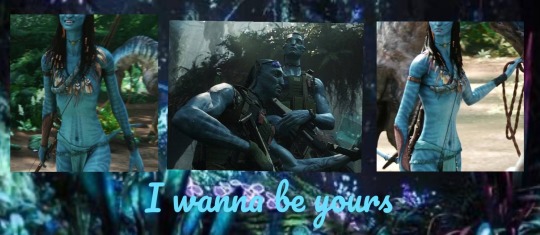
(Recom! Miles Quaritch x Sully! Reader x Recom! Lyle Wainfleet)
(Warning: Polyamorous relationship. Angst. Enemies to Lovers. Slow burn. Falling in love. Redemption arc. Canon deaths (but not really). Romance. Smut. Jealousy. Threesome. Anal(both F & M receiving). Mention of suicide, self harm, depression, anxiety. PTSD. Feelings being revealed. Jake and Neytiri not being good parents to reader. Reader being a motherly figure to spider.)
~~~~~~
Lyle peace was disturbed by his earpiece crackling and hearing the voice of Miles to check on them, seeing as you’ve been gone for a while. With a groan Lyle woke you up from your short slumber.
You lead Lyle to the river to wash off the stench of each other. Lyle of course didn’t like that, not one bit, he liked that you smell of him and wished you didn’t have to wash it off but he knows it’s for the best. He didn’t need the others to know what happened between the two of you.
Lyle being a gentleman, helps you in the water and massage your thighs and hips.
It’s been so long he has been with a woman, even as a human he hasn’t been with one. Since arriving to Pandora from Earth, he never once had the time to sleep around and it wasn’t because he didn’t want to, more like his Colonel had him do the randomest assignments, him being second in command couldn’t say no.
Not to mention the rule they had to not sleep with your coworkers.
Spending so much time together could lead a lot of sexual tension and feelings you didn’t know would have.
Especially when alcohol is involved, one thing lead to another, they both wake up in the same bed. Lyle remembers he tried to avoid Miles any chance he could, but it was hard when he was your boss.
Surprisingly it was Miles who made the first move and looked for Lyle. And when he managed to find him, he asked Lyle out to dinner at his chambers. Feelings were long overdue between the two of them.
Lyle guess they had a perk for them both being men and not worry about an accidental pregnancy.
Too bad Miles broke that rule first before having a committed relationship with Lyle.
“Was I too rough?” He ask. Not taking his eyes off the apex of your thighs.
“No. I’m just sore” you respond as you use the Yursyulang, gripping the flower and stroking it softly over his muscular chest and shoulders.
“Why didn’t you want to do that bond thing with me?” He ask. You pause your movement and look up at Lyle, hearing the obvious insecurity in his voice.
“Lyle.” You sigh, already pulling yourself away from him, Lyle panics thinking he offended you.
“Hey!” He whispers as he holds onto your hips a little tighter, not letting you have the chance to step away from him. “I’m not gonna get offended or anything. I just want you to be honest with me”
“It’s best if we don’t, atleast for now” you gently caress his jaw, “Besides where I’m from you’re still considered a child” you tease.
“Excuse me? Do I look like a child to you?” You had to bite your lip to stop yourself from laughing when you hear the obvious offensive tone in his voice.
“Lyle, I didn’t mean it that way. Back at home, you’ll still be considered a child untill you complete your Uniltaron. Dream hunt. After that you’re considered an adult”
There was a short moment of silence between you. Lyle just watches you as you continue scrubbing the flower all over his body.
He can get used to this. It feels so modernistic to him, so right. You look so beautiful in all your glory. To him you’re one of a kind. You look just like a dream. The prettiest girl he’d ever seen
He wish he could’ve had something like this when he was human but then he remembers he did. With Miles, till it all went down hill.
He wonders what could’ve happened if Socorro didn’t get pregnant, would Miles and him still be together? Would they be back on earth, possibly married? but soon as the thought appears, it instantly went away when the image of Spider appears in his mind.
Lyle adores Spider, of course human Lyle tried to raise him as his own before he got himself killed during the war.
Spider has gotten close with him and Miles. Something human Lyle always wanted.
If only Miles wasn’t a prick, things would’ve turned out differently, but if they had… would Lyle be with you like this? Would he have met you at all? What about Spider?
“You did the Dream hunt yourself?” Lyle breaks the silence. Wanting a break from his thoughts.
“Yes.” You answer. You cups your hand in the water and pours it over the oily residue left by the flower petals.
“So if I do it, I’m considered an adult?”
“Yes, that’s right”
“What happens during it?” His ears stand at attention, waiting for your explanation. He never heard of this, than again his human self didn’t care much of the Navi culture or traditions.
“During the ceremony, you will be stung by an Arachnoid then you will swallow a glow worm. Once that is done. You will be one of the people” you smile up at him.
“just like that? That sounds easy enough” that comment makes you frown, if only he knew.
“It isn’t. You will be in excruciating pain and often experience near-death. Often times Na’vi do not make it”
“Shit” he breathes out anxiously.
“My grandmother told me my father almost didn’t make it during his dream hunt”
“Seriously?” Lyle eyes widen in surprise.
“Mhmm. His heart stopped beating for a while” you reply as you take your turn with the flower. Rubbing the petals over your skin.
After a short while, Lyle grabs your wrist, stopping your movements. In confusion, you look up at Lyle seeing him with the most shit eating from you had ever seen. You groan already knowing what coming.
“My heart stops beating every time I look at you” he cheekily says, he leans down and presses his lips to yours briefly and smiles tenderly.
“Lyle! That’s so cringy” You blow out an exasperated breath as you pull your face away when he tries to kiss your lips again, only to kiss your cheek instead.
“C’mon that was a good one” he grunts when you avoid his lips. He lets go of your wrist and possessively wraps his arms around your waist, pulling you against his chest.
“It’s really not” you jest.
“C’mere baby” Lyle cooes, threading his fingers through your braid and pulling your face closer to his.
“No, get away from me” you grin, turn your face away to avoid his attempts, teasing him.
“C’mere” Lyle lips move on to kiss along the shell of your ear. A shudder courses through you when he tugs the sensitive lobe between his sharp teeth.
Pushing you against the edge with his hands on your hips. He spins your body around to have your back to him, and bends you over slightly on the edge of the river.
A shiver runs down your spine as the hand stays light, and gentle - tracing the length of your arms, and slowly gliding down the curve of your back.
Your breath catches, and you're laden with anticipation as Lyle’s touches stay grazing. You nearly hold your breath as his hands finally reach round your hips, climbing slowly back up your body until they're once more on your shoulders, pulling you gently back into his large, firm chest.
"Fuuck." He growled out, burying his nose in your hair on the side of your head, his hot breath fanning past your ear as he breathed heavily.
It’s no secret that Lyle adores you, but you’ve learned over the course of your “capture” that he is particularly fond of the way you smell. Your natural essence of spiced, sugared vanilla draws him in like a moth to a flame.
Your scent is like a drug. It calls to him – like a siren’s song – demanding that his primal instincts give in and help himself to his next hit.
Leaning back you can feel Lyle’s erection pressing into you from behind, but you ignore it for now, enjoying the feeling of his slick body against yours as his hands slide down your shoulders, and to your breasts.
Your thighs clench of their own accord, your empty walls clenching around nothing. Apparently your body was just as hungry for him as he was for you.
"Lyle, we don’t have time. We have to go back with the others," you say breathlessly as Lyle begins to knead them in his palms, gently rolling your nipples between the pads of his fingers.
Fuck that feels so good!
"They can wait," Lyle whispers huskily, kissing your neck. "I want to take advantage of the time we have now"
A smile spreads across your face as two strong hands turn your body around and warm lips find yours, sending tingles down your spine.
Lyle’s tongue parts your lips and finds your own tongue, beginning a dance much more skillful than the first your mouths had shared.
You let out a low, involuntary moan and Lyle swallows it entirely - rewarding you by sucking you bottom lip between his teeth and giving it a tug.
His hips rock into yours as your hands find his chest, running over his tight pectorals and rippling abs. You relish the feeling of his muscles beneath your finger tips, and pull your lips from Lyle’s, desperate to really look at the body you hold in your hands.
As you push Lyle away, you allow the glow from the plants surrounding shine of the water on Lyle’s skin to highlight to contours of his lean figure. You stare in awe at the beauty before you, and search for any signs of the hardships he has endured. But where you expect to find traces of a war-bitten body, you find nothing but cerulean. A flawless finish.
Lyle cups the side of your face, traces his thumb across your cheek as he admires your beauty. He can never get enough of it. He looks deeply into your eyes, he adores your eyes, he could never get enough of them. A sky full of stars and he was staring at you. He pulls your face against his to connect your lips.
The moment your mouths meet, Lyle shatters.
You can feel his heart race beneath the hand you have pressed against his chest, and a breathy moan escapes his lips as he lifts a single leg around his waist, spreading you open as his cock nudges your entrance.
Your tail wraps around his left thigh, it tightens its grip, subconsciously tugging him closer.
“Lyle” you gasp as the head of his cock presses against your opening. "Fuck," you choke out, breath catching as your pussy clenches, desperately seeking to be filled. Neither of you pay attention your surroundings or the sound of footsteps coming your way.
“What are you guys tak-HOLY SHIT!” Lopez cried, covering his eyes. “LYLE, WHAT THE FUCK!”
“LOPEZ!” Lyle scrambles to pull the head of him out of you. On instinct, Lyle pulls you behind him to cover your modesty. He doesn’t like the idea of anyone seeing what’s his. Especially since Lopez has being shamelessly eyeing you from
Lopez looks at you and Lyle with wide eyes, clearly surprised to see your state of affairs.
“Turn around, Lopez!” you shout over Lyle’s shoulder.
With an eyeroll, Lopez turns his back to the both of you. Lyle quickly jumps out of the water and helps you up. He puts on his boxers first before he tries to help you tie on your top and loincloth.
“If I knew this was going to happen, I would’ve volunteered to come instead” Lopez shouts over his shoulder. Lyle growls clearly unamused by Lopez idiocy.
You give a gentle squeeze of assurance on Lyle’s forearm, one look at your gentle eyes, his shoulders sags from being tense by Lopez comment.
Once you and Lyle finished dressing, Lopez turns back around with a shit eating grin.
“Keep dreaming!” You growl, your face flush from embarrassment. With a glare his way, you cross your arms across your chest.
“I will! For the rest of my life. You’re the finest woman I ever met” Lopez unfazed by your penetrating glare, kept his gaze on you as they fall on your hips, seeing the clear finger print marks bruising your blue skin
“Lopez! Do you ever shut up, man!” Lyle pinches the bridge of his nose, clearly annoyed.
“Not when I just walked into something like that. Is this why you two took an hour here?” Lopez ask as he points at the two of you. Lyle sighs before looking at you.
What the fuck is he going to do?
“Lopez, can you keep this to yourself?” Lyle ask, it’s stupid of him to even ask since Lopez does have a big mouth but what other choice does he have.
He can’t have the other know and be reported back to Ardmore. You and Spider are his top priority right now.
Lopez looks at Lyle in surprise. Lopez doesn’t do well with secrets, he never has, he doesn’t like the pressure of it.
“What? You want me to keep this a secret? Aww man! Lyle, you know I don’t do well with secrets” poor Lopez is stressing.
“Well you should’ve thought of that before coming out here” Lyle retorts through clench teeth, his tail sways agitatingly behind him.
“Hey! No seas mamon, güey! Tell that to the Colonel, he ordered me to come find your ass and look what that got me!” Lopez defends himself.
“Shit!” Lyle curses under his breath.
“Atleast it wasn’t Spider. He almost volunteered to come if it wasn’t for Quaritch sending me instead” Lopez shrugs. Your eyes widen at that.
It would’ve been the end of the world for you if it was Spider who walked in on you instead of Lopez.
“Just keep your mouth shut about this, alright? I don’t need the others to know our business”
Lopez groans before agreeing, “fine, I got you” you watch silently as they both fist bump each other.
“C’mon baby” Lyle beacons you closer, “we’re heading back” Lyle bends over and grabs his vest. He slides it over his head as the three of you starts making your way back.
You walk ahead of them, Lopez and Lyle a few feet behind you as they look around, admiring the flora. Quietly talking among themselves.
“Are you fucking loco in the head, Lyle?” Lopez whispers. Lyle mentally cringe, he knew he probably shouldn’t have acted on his impulse. But he had to have you, one or another, he just had to. If it wasn’t for you pushing his hand away from your queue, he probably would’ve connected his kuru with yours.
“Lopez, this ain’t none of your business, man” Lyle sigh tiredly.
“None of my business?” Lopez is in disbelief at his Corporal, “dude I just walked in on you almost fucking our “prisoner”” Lopez does air quotes with his fingers.
Lyle frowns, “first off, don’t call her that..”
“Wha-“
“Second…” Lyle cuts Lopez off, “We weren’t “almost” fucking” Lyle sighed, scratching an eyebrow with his thumb, getting annoyed with his fucking ass-hat of a friend.
“The fuck does that mean?” Lyle sighs, Lopez doesn’t take his gaze away from Lyle’s side profile till it clicked. Lyle cringed when Lopez stops walking and looks at him with wide eyes.
“Oh. My. God. Lyle, tell me you didn’t” Lyle side glares Lopez for his accusations.
Lyle glances at you, walking ahead of them, before looking at Lopez, clearly wanting this conversation to end.
“Lopez-“
“No, Lyle. Tell me. Did you or did you not mate with her?” Lopez brows furrowed. He’s not asking cause he’s mad, he’s asking cause he’s worried for the well being of his friend and you, the Navi woman he has grown quite close to. Yes he has joked about having a crush on you but that’s just it. A crush.
“No, Lopez. We didn’t” Lopez hears the dejected tone in his voice and it makes him exhale a groan.
“What about Miles?” Lyle raises his with a raised brow at Lopez
“What about him?”
“Man…” Lopez shakes his head in disbelief, “you really are a fucking knucklehead.” He smiles at Lyle’s jumbled face, “The team and I aren’t as naive as you and the Colonel think” Lopez jokingly punch Lyle’s shoulder.
“Que rabiosa” Lopez shouts at you, noticing your weird walk, and it made him laugh historically.
You look behind you seeing Lyle glaring at Lopez and shoves his shoulder.
“Lopez! Shut up, man!”
“Alright, alright, jeez. I see you’re frustrated, is it because you didn’t cum?”
“Lopez, keep moving before I beat the shit out of you”
——
“Took you long enough” says Miles as he watches the three of you come into view, his eyebrow raise when he sees you wince when you sat down on a fallen log, “what’s wrong, darlin?”
“Nothing” you wave him off, Lyle sits next to you and offers you some fish, you take it with a smile. Lopez sits the other side of you.
Spider watches the interaction between you and Lyle as he eats. He found it odd when just this morning, you were ignoring him and now you two… Spider eyes widen in a realization, causing him to choke on his food.
“Spider” Miles lightly scolds him as he gently pat on Spider’s back, “we talked about you scarfing down your food too fast”
Both you and Lyle turn to look at Spider in worrisome. Spider waves off everyone’s concern, making eye contact with you. He gives you that look that you know all to well.
Oh shit! He knows!
“Where you going?” You ask Spider when you see him stand up.
“I’m tired. I’m going to sleep” he answers with a yawn, you see him grab the hammock from Miles bag.
“Let me set it up” you say with a wince when you try to stand.
“Baby, let me. You sit down and eat” Lyle grabs you by the wrist to gently guide you back down. Lyle stands up and dust his pants before following Spider up a tree to set up the hammock.
But before Spider could climb the tree, Spider gives you a look, that look, telling you, you better follow him and tell him everything. You gulp nervously. He was fake yawning.
Oh eywa, please help me and not let Spider kill me!
“Amor is very beautiful, ain’t it mami?” Lopez teases you as he bumps his shoulder against yours.
“What?” You blink at him.
“Love. Not only do you have one man but you have two” Lopez emphasizes by holding up two fingers. You frown.
“Lopez, where are you going with this? I don’t have two men” You glance around and feel grateful when no one seems to be listening on the nonsense Lopez is spilling. Two men? What the hell is he talking about?
“You heard me, mami” the man grins, scooching over and leaning forward to look at your face, “not only do you have Lyle wrapped around your finger but you also have our fearless Colonel” he hummed suggestively and you lean back a bit.
“I think you’re seeing things, Lopez” you suggest with an eyeroll.
“I’m seeing the way you look at them” he hums and voice turning gentle.
“Lopez-“
“Anyone with eyes could see that. We could also see the way they look at you” Lopez smiles softly and your eyes darted around, landing on the ground.
“Don’t you have someone else to bother?” At that Lopez laughs loudly and you drew your lips into a thin line in embarrassment.
“Lopez, has your mother not teach you not to bother a lady?” Lyle grumbles with a raised brow as he walks towards the two of you, glaring at Lopez.
“Oh you mean your lady?” The Latino wiggles his brows and Lyle furrowed his, drawing his lips into a thin line as he walked over and kicked Lopez in the chest, throwing him backwards off the log.
"Ow, pinche baboso!" He called out, scrambling to his knees to look at Lyle in offense.
"Go bother someone else” was Lyle’s reply, dismissing the man on the ground as he instead slung his leg over the log to your right, sitting down sideways so he could face you.
"Protective much.." Lopez grumbles in a murmur as he gets up, dusting himself off before hopping back over the log to continue to bother someone else, poor Mansk, but not before sending you a wink.
“That asshole” Lyle mumbles, you giggle at him before looking around the small group.
They all seem to be talking among themselves about thing you don’t understand. Miles seems to be the only one that looks distracted.
He seems to be deep in thought, and it worries you.
“Is he okay?” You whisper to Lyle. Lyle picks up his head to look around then back at you with a confused expression.
“Who?”
“Miles” you answer. At your verification, Lyle instantly look at Miles. You see the flicker of anxiousness on his face.
“You’re his friend, why don’t you go talk to him” you suggest.
Lyle sighs heavily, “Baby-“
“It’s okay.” You cut him off. It’s obvious he is worried about Miles, but he’s apprehensive about leaving you on your own. Which you appreciate. “You go. I’m exhausted anyways. I’m going to head to the hammock with Spider” you place the leaf down beside you.
“I tired you out, baby?” Lyle asks and looks with a mischievous smirk up at you. You shake your head, with a quiet whimper, you manage to get up on your own. Lyle subtly reach his hand in case you stumble or fall.
“Don’t let it go to your head, oeyä tìyawn” (my love) you shove his head playfully with a small smile. Lyle sways slightly backwards to exaggerate you pushing him.
“Wait…” Lyle blinks, “what does that mean?”
You shrug your shoulders with a small grin. You step over the log to make your way to the tree.
“Baby, wait- what does it mean?!” Lyle shouts at you.
“Goodnight Lyle” you wave your hand, not looking behind you. You giggle when you hear Lyle groan in frustration.
He should’ve paid attention during your lessons, instead of gawking at you.
With a grunt, you hoist yourself on a brunch and start climbing towards your shared hammock. Right when you’re about to reach, Spider jumps out.
“What the fuck did you two do?!”
You shriek, almost falling backwards. Grabbing your bearings, you catch your balance. You take a deep breath of relief before glaring at Spider for almost falling to your possible death.
“Darlin? You alright up there?”
You turn your glare away from Spider and look over the branch to gaze down at Miles. Miles is looking up at you with his hands on his hips with his regular scowl but the flick of his tail gives him away. your gaze soften.
“Yeah, I’m okay, Colonel” you shout back.
His gaze seems to linger on you, eyes flickering over your face and tail flicking erratically behind him. His lips seem to twitch up just slightly at the corners. Eventually, Quaritch nods in acquiescence before moving toward the group.
“Alright, sweetheart.”
You watch as Miles makes his way to sit down next to Lyle who seems to be deep in conversation with him.
“Ahem”
Hearing Spider, you almost forgot why you’re up there in the first place. You look at Spider with deadpan expression, almost glaring.
“Spider, what the fuck. I almost feel, nga vonvä’” (you asshole) you sneer down at Spider, who seems unfazed which annoys you. A lot. You sit down criss cross on the branch closest to the hammock.
“Tell. Me . Everything.” You throw your head back with a groan, it’s embarrassing enough that Lopez caught you in the act, now Spider wants you to tell him.
“There’s nothing to tell, Spider” you avoid the topic.
“Really? So you being gone for almost and hour has nothing to do with the bruises on your hips, which by the way looks like the size of Lyle’s hand, is nothing?”
You stare at him harshly for a moment longer before sighing and shake your head in acquiescence. In the grand scheme of things, it wasn’t something all that serious anyways. Kind of. Atleast to you.
Spider inhales deeply when he looks away from you. You almost feel like you disappointed him, but why do you feel such a way?
But Spider doesn’t feel that way, he’s worried, scared even. If it were in a different situation, he would’ve been happy for you.
“Did you mate with him?” You tug your bottom lip in apprehension, you don’t blame Spider for asking, but it doesn’t make you feel less embarrassed.
You sigh, knowing this conversation was going to happen soon. "No. But I think he wanted to." You say, knowing he wasn't going to accept that.
“What do you mean?”
You absentmindedly play with your songcord to keep your hands busy.
“When we ~ahem~ about to… you know” you wave your hand around dismissively.
Spider took a minute till it hit him what you meant. His face scrunch up in disgusted and groan.
“Ew”
“Spider!” You shout offensively before pouting.
“Okay. Okay.” Spider dramatically takes a deep breath, shaking his head to clear out the image he did not what to think about, “I’m sorry, continue”
You roll your before continuing, “he grabbed my queue, I saw the look in his eyes, he wanted to connect our kurus but I stopped him”
“Why?”
“Cause he’s not considered as an adult to the people”
“Bullshit” He says.
You let your songcord fall on your thigh and take a deep breath. “What do you want me to say, Spider?”
“The truth. Don’t give that bullshit”
“Like what? Tell you that I’m in love with Lyle? That I fell for him?” You frown, “Yes Spider, I did.” Your fingered twitch, “Yes we’ve… gotten intimate, I wanted to officially mate but…” you close your eyes
Spider waits, watching you think before speaking, “But what?”
“It didn’t feel right, okay?” You look down at your palms.
“Why not?”
You shrug, “I don’t know”
Spider leans back on the tree and crosses his arms across his chest. "You’re in love with my dad too. Aren’t you.” He says, and it's not a question.
“Yeah”
“You fell for them, knowing they’re here to kill Jake and take over Pandora”
“I know” you say as you continue to play with your songcord.
“You know this won’t end well”
“I know” you say again.
“And yet you fell for them”
“Yes” you sigh.
“I guess the apple doesn’t fall far from the tree”
Your head spins towards him and this odd shift in tone. “What?" I say with a confused chuckle.
He smiles at you. “I know the story, Y/n. Neytiri was forced to teach Jake the way of the people. And along the way they both fell for each other. You’re somewhat in a similar situation… that has to tell you something”
You chuckle, “yeah, that I’m an idiot like my mom”
Spider brings his hand up and smacks the side your head.
“Hey!” You say, recoiling from him.
“No, you Skxáwng. Maybe history will repeat itself, and they’ll change their ways. Like Jake did.” he says, and you’re honestly just relieved that he isn't upset with you.
Change their ways? If only. But… you have seen the dramatic change in every single one of them. Lyle did say he doesn’t care about the mission. But do the rest feel that way too?
Then you remember… the Atokirina.
You lean closer to Spider, lowering your voice, “The great mother gave me a sign”
Spider eyes widen, “what?”
You bite you bottom lip, anxiously, “an Atokirina landed on both Lyle and Miles.”
“Eywa sees them” Spider gasp, awestruck.
“Look, I would never question the great mother’s doing. But I have yet to understand what she sees in them”
“Didn’t you just said Lyle doesn’t care about the mission anymore?”
“Yes but-“
“If you made Lyle change, who to say you don’t make the others change too?”
You stare at him in disbelief, waiting for his expression to crack. But he is clearly serious.
“Spider, that isn’t up to me, it’s up to them if they…”
“You don’t see it? Do you? They’re all in a constant turmoil in their minds.”
“But…”
“Eywa holds all her children in her heart. And that includes them. Whether they see it or not. They do. I see how much they’re starting to see the beauty of Pandora”
Your eyes cast downwards, not knowing how to respond to that. But you do know to you feel.
You’re scared.
Oh how your parents would kill you for being in this situation. Oh your poor grandmother. First her daughter mates with a demon and now you… falling for two demons. What would she think.
Spider reach for your hand, your head snaps up, “I know you’re scared. So am I. But if the Eywa touch them…” Spider cringe at the word, making you giggle, “wait no, I- that sounds wrong. Let me try again,” he clears his throat, “IF Eywa approves of them, then she knows” he assures you.
You didn’t even realize you were crying till you felt tears drop to your thighs. Spider sees and gently pulls on your wrist. You lean down and he wraps his arms around your shoulders, comforting you. It was an arkward angle but it was comforting none the less.
“So… Lopez knows… doesn’t he”
“Yeah” you laugh. Spider gives you a tight squeeze before letting you go, “he walked in on us”
Spider eyes widen, “good thing my dad denied me going. I didn’t need to see that” Spider shakes his head.
“Yeah” you laugh, “Lyle made him promise he won’t say anything.”
“You think he won’t?”
“I really hope so” you exasperates. You and Spider laughs.
“I’m actually tired so, I’m going to sleep for reals” you jokingly push Spiderto give you room on the hammock.
“Fine.” Spider moves before looking at you seriously, “did you atleast bathe first before coming here? I do not need you smelling like sex”
“Spider!” You blush, smacking his harm, Spider laughs.
(I’m sorry again for my absence. I do feel guilty on leaving like that. I feel like this is more like a filler, if you know what I mean. I promise the next chapter would be better I promise. Also please comment and let me know. You guys know I love to hear what you think☺️❤️)
Taglist: @alexandra-001 @commanderrivercc-3628 @henhouse-horrors @certainkittenpeach @multi-fandom-rando @zzedah @mrstargayen09 @loaksulluyswife @averagehorrorgirl @baybaybear1 @deathlypink @ratchetprime211
#i wanna be yours#miles quaritch x reader#lyle wainfleet x reader#recom lyle wainfleet#recom miles quaritch#polyamarous#avatar the way of water#spider x reader#miles quaritch#polyamory
129 notes
·
View notes
Text
do you know how infuriated Loki would be that western society acts as if literature written by old white men is canonically superior?? that white men following the socially acceptable religion wrote texts about how they were emotionally detached from society or spiritually disconnected and alienated?? where they complained that technological process was a purposeless burden because it wasn't personally ‘working for them’?? if they weren't all dead he would’ve straight up roasted them alive
#this realm has divided itself into hundreds of vast unique cultures and Y'ALL DECIDED YOU WERE THE BEST?? WHY??''#''T.S ELIOT WRITES LIKE AN ANGSTY 13 YEAR OLD THAT CRIES HIMSELF TO SLEEP EVERY NIGHT''#WHAT DO YOU MEAN HE'S THE ONE REMEMBERED FOR THE MODERNIST MOVEMENT?? WHAT ABOUT EMILY DICKINSON??''#''IF YOU'RE GIVING SOMEONE A TITLE AT LEAST MAKE SURE THEIR WORK DESERVES IT!?!''#''what DO YOU MEAN A WOMEN STARTED THE GENRE AND NOW MEN MAKE IT A THEM-ONLY THING?? genDER IS A SOCIAL CONSTRUCT??''#''oh would you look at that Shakespeare's actually got decent work with textual integrity. he can stay. Oscar Wilde's 1 book is good too''#''ANOTHER OLD WHITE MAN WHO IS CONSIDERED A LITERARY CRITIC AND IS SELF-ABSORBED??? WHY WOULD MIDGARDIAN SOCIETY DO THIS???!?''#''OH BOO HOO YOU WERE SAD AND DIDNT SEE PURPOSE IN LIFE - YOU'RE NOT SPECIAL - STOP CREEPILY WATCHING WOMEN IN THE STREETS PRUFROCK!!!''#Loki would absolutely whip out a thousand years of literary criticism knowledge to roast education systems everywhere about what they teach#forget Thor 1 what I want to see is Loki getting banished to earth and becoming someone that specialises in literally E V E R Y T H I N G#he starts by posting a few scientific papers online with a few theories he's got on how stuff works and how earth materials could test them#then he moves on to publishing a YA novel#youtube cooking channel specialising in desserts of various cultures and he collabs with people of those cultures to get things right#Margaret Atwood who#watch as 1 person asking an off-hand question about his fave Shakespearean work spirals into an hour analysis of what makes a tragic hero#stark hears about loki's model for a clean renewable energy source and the physics blows him away#loki uses stark's research fund money to open a fashion line#he doesn't waste money on hiring models and when that one decently popular sh*tp*ster used his account to advertise he blew up online#someone eventually reminds odin that he banished one of his children on earth but suddenly the insolent child doesn't want to return#he'll have his magic back though thank you#loki: marginalisation is an actual thing#Asgard: *booing him*#Earth: *cheering*#Odin: why don't u want to come back son
452 notes
·
View notes
Link
As you probably have heard in the news, earlier in August a Pennsylvania grand jury handed down a 1,356-page account of sexual abuse which involved around 1,000 kids and 300 priests during a period of approximately 70 years. It is another pedophilia scandal within the Catholic Church that adds up to their collection of countless other ones reported in recent years.
The commie pope—while on his two-day visit to Ireland—begged for forgiveness again, just the way he did in Chile back in January of this year.
You can notice how quick and scathing the mainstream media is to denounce these recurring events, after all we know who owns the MSM and the (real) Church has a long, well-known history of “anti-semitism” and resistance against the tentacles of globalism. I wish the media had the same commitment to inform the existence of other pedophile rings full of high-ranking people as well.

Is the problem of the church’s innumerous sexual abuse allegations really pedophilia? To me there is a deeper explanation for it, and that explanation is: homosexualism. 81% of the alleged victims are male and three-fourths of them are post-pubescent. As you guys are certainly aware of, the Church has a very big issue with homosexualism among its clergymen.
I have a theory for the high presence of gay men inside priesthood: until not long ago being gay was definitely not ok, homosexuals were not accepted as they are now, so they became priests.
The developed Western world of today encourages people to become gay, it applauds individuals for their gayness, but it wasn’t always like that. Now, try to imagine a closeted homosexual man living in the 50s, for example. What a better place to go than the Catholic seminary? People wouldn’t look you down, you wouldn’t have to get married, the place was filled with other young men (potential sexual partners) and that’s how the Church got corrupted by perverts.
Pedophilia x Homosexualism
One normie could argue “how homosexualism relates to pedophilia?” Any red-pilled person who has ever wondered what causes someone to become gay will notice that there is an undeniable link between pedophilia and homosexualism.
Let’s remember the occasion of Milo Yiannopolous’ resignation from Breitbart over comments which seemed to endorse sex between “younger men” and older men. Something that is—as he pointed out—extremely common among gay men. A 2009 report revealed that 74 percent of bisexuals had been sexually abused as children, I am pretty sure homosexuals follow the same numbers.
I won’t say homosexual behavior is exclusively caused by pedophilia because human (or animal) sexuality is a very complex topic which can certainly involve many variables. I just don’t buy that “born this way” hype, until this day not a single reliable proof of the existence of a gay gene or anything like it was discovered.
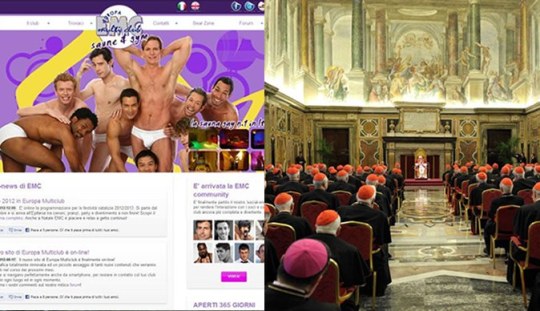
The Vatican once bought a £21 million apartment block above ‘Europe’s largest gay sauna’.
Pope Francis, a champion of the left-leaning agenda inside the Church, has been accused of covering up former Cardinal McCarrick’s abuse allegations (one of the many cases in Pennsylvania). The accusations were made by Carlo Vigano, a former Vatican ambassador to the US, and if it proves to be true–I am positive it is—that should result in pope Francis’ resignation. As a traditionalist Catholic myself I would be delighted with such an event.
Francis has already been complacent with other pedos before. One good example is the 2015 ‘Synod on the Family’ when the pope invited Godfried Danneels, a Belgium Cardinal convicted of covering up pedophiles in the 90s, to attend the meeting. Danneels is a hard-left priest that tries to push the Church ” liberal reformation” and admitted that he was part of a plot against (right-leaning) Pope Benedict and in favor of the election of leftie Francis.
To affirm that the Church’s gay/pedos are exclusively part of the left-wing priesthood would be too Manichean. I am sure there are tons of sick people who lean right also. But it can’t be denied that the liberals make up the vast majority of these issues involving sexual misconduct.
“Religious progressives”
For those who don’t know, the Catholic Church, just as any other political institution, is divided in factions that tend to be more liberal or orthodox. The liberation theology, for instance, is a movement created inside the Catholic Church (and some Protestant denominations) which aims to mix Christianity and Marxism.
Even if you are an agnostic don’t underestimate the influence they played in various regions such as Europe, Latin America and even New England. Brazilian Workers’ Party attributed their success to this movement and Unions.
Be wary of any religious leader that tries to push a liberalization of dogmas and traditions. Because all religions are intrinsically conservative according to their respective contexts, they establish doctrines that dictate sets of rules that must be followed properly in order to attain their objectives (whether is Salvation in Christianity or Nirvana in Buddhism). There are no (real) religions without their traditions.
Whenever you see liberal religious men doubt their characters. There is a good chance they don’t even bother with religion or spirituality, perhaps they are closeted atheist. What they do care about is the religious platform, which can offer various benefits such as large audiences, political influence, money and even sex.

Estimates of the number of gays in the priesthood are all over the lot, from 20 percent to 60 percent, although a Los Angeles Times poll in 2002 found only 15 percent of priests saying they were homosexual or “somewhere in between but more on the homosexual side.”
Every time pedo priests’ cases pop up in the MSM, secular people are very quick to point fingers and show their moral superiority, but they “forget” the existence of secular institutions that are way more sexually perverted than the “gayish” modern Church, such as Hollywood, the political and corporate world.
Real Church x Sissy Church
It is also important to notice that the Church was emasculated, an emasculation that took place during the process of secularization and establishment of liberal democracies across the Western world (e.g. French Revolution).
The Church had to be softened, becoming an institution that barely resembles the once powerful and great Church of the Crusades or the Inquisitions. This same phenom of emasculation can also happen in other secular institutions too, the Military, mainstream Music, Politics, Sports and even Boys Scouts. And it will only get worse as liberal-democratic globalism advances, so secular people: watch out!
St. Basil the Great, a 4th century bishop and Doctor of the Church, defended that gay/pedo priests should be publicly flogged. That was the (real) Church, not this sissy catholicism created after the Second Vatican Council (a modernist reform imposed in the Church from 1962 to 1965). A lot of things got bad in the 60s.
The (real) Church has a very important and vigorous story in the construction of the West. Always being a target to the globalists and that breed who rules the world, a clear obstacle to their goals.
Examples are many: Gabriel García Moreno, Catholic Equatorian president, who made a terrific job in a Confessional Equator and was killed by the Freemasons; Saint José Sanchez del Rio, who was killed by Mexican secular, freemason and leftist government with the support of the US, for refusing to abbandon his faith.
Inconvenient truths are ignored
The media only goes after what is convenient to their narrative, don’t expect them to expose Hollywood pedos nor the obvious link between pedo priests and homosexualism. The left has already pushed the normalization of pedophilia many times and I didn’t see the indignation of the MSM.
Late Vatican’s Chief Exorcist Gabriele Amorth once said, “The Devil resides in the Vatican and you can see the consequences”.
“The floor of hell is paved with the skulls of bishops”. – St. Athanasius
Read More: The Vatican Has Disgraced True Catholic Values
I have noticed that many people have been falsely conflating what comes out of the Vatican as Catholic. Thus it is my duty to present to the esteemed readers of this fine site the true teachings of the Church which stand, ever more so today, in stark opposition to the rot of cultural Marxism and the effeminacy of the Papal pretenders in Rome.
Vicar of Christ?
Church authorities are not legitimate
It is a dogma of the Catholic faith that the Church cannot substantially change. This means that the church cannot contradict nor change her teaching from what has always been universally taught or has been solemnly defined. Any one who claims to be Catholic and knowingly professes a faith which contradicts a teaching of the Church is considered to be a heretic and is considered to have a removed himself from the Church.
As St. Thomas states: “[one] who disbelieves [even] one article of faith does not have faith, either formed or unformed.” This is known as the unity of faith which means that all Catholics profess the same faith. Likewise it means that heretics cannot hold a clerical office in the Church. Thus if a heretic were to be elected even to the Papacy they could not be considered a legitimate Pontiff because a heretic has separated himself from the Church (source).

Would a real Pope bow to a religion declared false by the Church?
Simply put, you have to be Catholic to be Pope, and the absurdity of a heretic claiming the See of Peter is where we find ourselves today. For just as the institutions in the West have been infiltrated and seized by the enemy, likewise have the institutions of the Church been usurped by apostate forces. The hierarchy currently residing in the Vatican are not legitimate authorities and do not represent the perennial teaching of the Church. Therefore I have listed for your benefit the actual Church’s positions on some current areas of contention.

The only time Francis has ever smiled at a Crucifix
On Communism
The Catholic Church is vehemently opposed to communism. Without Pius XII valiant efforts, communism would have prevailed over postwar France and Italy. The Pope went so far as to issue the Decree against Communism in 1949 which excommunicated any Christian who professed communist doctrine.
Catholicism is the enemy of Marxism as it teaches that there can be no separation of Church and state, and an atheist government is immoral. Catholicism believes private property is a natural right going so far to say that depriving workers of their wages is a sin which cries to heaven for vengeance (compare that to our socialist tax code!).
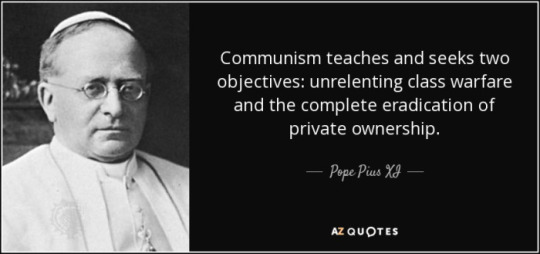
On Migration and Culture
The current Muslim invasion of Europe would be met with the utmost resistance. It has always been the Church which has sought to safeguard Catholic Culture and in ages past has gone so far as to issue a call to arms against non-Catholics who have sought to destroy it.
Pope Urban II issued the Crusades and Pope Leo the great even went so far as to personally travel into the heart of the Hun army—to Attila himself—to deliver Rome from the sack that was to come. In 1571, St. Pope Pius V formed the Holy League that would go on to defeat the great Muslim Turkish Armada that was plaguing the Mediterranean.

“Then I pointed like so and told them where to take their cultural enrichment”
The tradition of the Church has been to unite the West against external non-christian threats in order to preserve Western Christian culture.
“The natural law enjoins us to love devotedly and to defend the country in which we were born, and in which we were brought up, so that every good citizen hesitates not to face death for his native land…. We are bound, then, to love dearly the country whence we have received the means of engagement this mortal life affords.” – Sapientia Christiana Encyclical Pope Leo XIII
On Abortion and Contraception
So what is the real teaching of the Church in regards to abortion and contraception? The teaching is any member who has an abortion or supports abortion is automatically excommunicated from the Church. That’s right: every single Democrat who claims to be Catholic is actually excommunicated, including Nancy Pelosi who likes to sanctimoniously drone how she is a good Catholic grandmother.
Contraception is also considered a mortal sin because it is an unnatural stoppage of life.
“Hence, after the sin of homicide whereby a human life already in existence is destroyed, this type of sin appears to take next place, for by it the generation of human nature is impeded.” -St. Thomas Aquinas.

I know this is unpopular with the readers, but the teaching is that those who engage in contraception have already committed murder in their heart. Contraception is what allows people to engage in recreational sex, because the natural end of sex has been set aside so too then has the institution of marriage, whose end is children.
Likewise, because we have committed murder in our hearts, we have become a petulant, immature, vain, and a sterile people similar to any other people who have taken the risk from reward or the consequences from pleasure. This is the most difficult pill to swallow.
On Feminism
The Church condemns feminism in the strongest terms. There cannot exist feminism without birth control.
“…any use whatsoever of matrimony exercised in such a way that the act is deliberately frustrated in its natural power to generate life is an offense against the law of God and of nature, and those who indulge in such are branded with the guilt of a grave sin.” -Pius XI Casti Cannubi
The Church asserts that Man is the head of the household and that a woman finds her vocation from being a good mother and housewife:
“This … does not deny or take away the liberty which fully belongs to the woman both in view of her dignity as a human person, and in view of her most noble office as wife and mother and companion; nor does it bid her obey her husband’s every request if not in harmony with right reason or with the dignity due to wife; … For if the man is the head, the woman is the heart, and as he occupies the chief place in ruling, so she may and ought to claim for herself the chief place in love.” -Ibid
The Pope has even gone so far as to condemn women’s suffrage:
“Woman can never be man’s equal and cannot therefore enjoy equal rights. Few women would ever desire to legislate, and those who did would only be classed as eccentrics.” -St. Pius X

On Pacifism
The Catholic Church is not simply just a religion of love and mercy. Christianity is not a weak religion, for our God is a God of Battles. Catholic Tradition encourages us to live our lives in the manner of our Lord Jesus who spoke of the struggle that his Church would have to endure.
“Do not think that I am come to send peace upon earth: I came not to send peace, but the sword.”-Mathew 10:34
Christians are not meant to sit idly as bystanders to the great struggle of good and evil in this world.
“For our wrestling is not against flesh and blood: but against principalities and power, against the rulers of the world of this darkness: against the spirits of wickedness in the high places.” -Ephesians 6:12

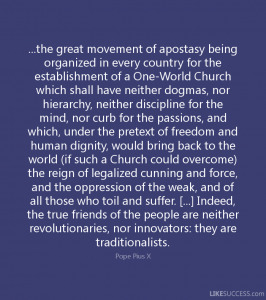
8 notes
·
View notes
Text
Iran Classic Tour
Travel Hub Iran is an online journey agency offering Iran’s most inspiring selection of reasonably priced FIT or group tours, safaris and actions. Our journeys embrace authentic accommodation, unique delicacies and local transport to put vacationers on a first-name foundation with the planet’s people, cultures, landscapes. Tehran Urban Adventures provides day excursions with an area expert information in Tehran.
On this present day, you will be pushed to the airport of Shiraz to fly back to your country. You can discover it in all restaurants in Shiraz, but when wish to eat the most effective one, I suggest you eat at Haftkhan restaurant. Haft khan restaurant is doubtless certainly one of the best restaurants in Shiraz that has seven flooring and also you can eat different kinds of food there. Haft khan restaurant can also be well-known due to serving scrumptious Shirazi Halva.
Enjoy two full days exploring this stunning city, Iran’s capital from 1598 to 1722. Begin in the Maydan-e Shah, or Royal Square, stopping on the exquisitely tiled Lotfallah Mosque, the Ali Qapu Palace and the towering portal of the Shah Mosque. Visit three of the 5 bridges that cross the Zayendehrud River, together with the beautiful two-story Khaju Bridge. Celebrate the top of our extraordinary journey at a farewell dinner. Along the way stop at the website of Pasargad, near which Cyrrus the Great built the first Achaemenian capital. Upon arrival in Shiraz, stop at the tomb of the celebrated poet Hafez earlier than checking in to our hotel. Savor dinner at a delightful native restaurant this evening.
The Exploration Of Sustainable Landscape In Iran
Still, the separate palaces are scattered apparently based on no rule, so that it isn't an easy matter to reconstruct (as in a measure it was potential to do in the Egyptian temple at Deir-el-Bakhari) the good common garden-terraces. But in any case the terraces with massive backyard websites have been indubitably right here. The woodlands and gardens around their tombs had been very important to the traditional Persians. The tomb of Cyrus the Great was enclosed by four-gardens known as "Chaharbagh" and a grove, and his son Cambyses entrusted the care of it as a hereditary office to a household of Magi; when Alexander saw it, it had grown high however had been neglected.
Pomegranate, almonds and persimmons are the fruit trees of this backyard that give a special character to this place. 家事服務 to the flowing of water inside it, Pahlavan Pour was a beautiful backyard from the late Qajar period. Most of the water in the garden is instantly offered by Hasaabad Qanat, and this water, except to the Pahlavan Pour, does not instantly go to any of the gardens in the space. A large pool, water circulation and the greenery of the trees are solely a half of the attraction of this backyard. The great thing about Isfahan is greatest described by the proverbial saying, Isafahan is ‘Half of the World’. Our full day tour includes visits of the Meidan Emam or Naghshe Jahan Square and go to Sheikh Lutfollah Mosque, Emam Mosque, Ali Qapou Palace and Qeisarieh Bazaar with hundreds of outlets displaying native arts and handicrafts.
People’s fixed go to to particular areas on this backyard, has helped shape number of hangouts which in turn have created new identities for these areas. Large-scaled gardens nonetheless present their unique vegetation which makes it best for peace-and-quiet seekers who need to be away from the hustle and bustle of cities for just a while. You could say that gardens at present are considered a backyard for major cities; they could symbolize a green gateway to their lifestyle, social values, micro cultures, and the complex story of all those who have stepped in it. In the guts of Yazd desert, Abarqu County stands tall and proud one of Iran’s nationwide monuments generally identified as Sarv-e Abarqu . 6- The traditional Persian Garden design has also extensively influenced Persian carpet patterns.
Why An Iran
After land acquisition, shrine tasks are then totally funded by Iran – ostensibly from donations by devout Iranian Shi’ites and thru charities linked to Shi’ite shrine organisations, officials at the Hussein shrine mentioned. An Iranian worker of Kawthar, who declined to be named, said a lot of the money came from Iranian state coffers, however he didn’t know what quantity. A project costing in extra of $600 million “can’t simply come from donations, you want a state behind that,” he reasoned. The Iraqi state funds the initial shopping for up of personal and public land on the websites by way of price range allocations to Shi’ite religious authorities which make the acquisition, stated Rekani, the previous housing minister.
It is considerably more frequent than the older atashkada, a Classical Persian language time period that together with its center Persian predecessors (𐭪𐭲𐭪 𐭠𐭲𐭧𐭱 ātaxš-kadag, -man and -xanag) literally means 'home of fireplace'. The older phrases have the advantage that they are readily understood even by non-Zoroastrian Iranians.
Arab geographers referred to as this place the fire-temple of Marabin or Maras. Masudi in Meadows of Gold stated the temple was originally devoted to idol-worship and it was made into a fire-temple by King Vishtaspa, Zoroaster's authentic patron.
Built between 1964 and 1970, its concrete exterior blends in with the gray of the encompassing cityscape, but the inside features colourful modern takes on traditional Armenian artwork. Iran’s strong contender for the title of world’s largest mosque, the Mosalla complex has been under building for the reason that Nineties. Architecturally somewhere between modernist and area age, with 230 meter excessive minarets and a site masking some 650,000 square meters, Mosalla is a striking manifestation of the Islamic Republic’s program of public works. It can additionally be notable as the house of the similarly enormous Tehran International Book Fair, which attracts tens of millions of holiday makers yearly. According to authors from the 1800s, between the time when the atash gah was abandoned by the Hindus in the and Modi's visit in 1925, that is, in the 1800s, the Surakhani atash gah was briefly beneath the care of Zoroastrians.
Ryokan Vs Onsen
Instead of bathing, white linen undies, soaking up toxins and smells, grew to become the solution of keeping the body clean. Soap was created from water poured over ash and boiled with mutton fat and herbs. 清潔公司 created a ball of scented soap lye that might be rubbed on linen and clothes. A flat paddle, called a washing bat or beetle, was used to hit the clothes in the course of the washing process – an old fashion of washing garments. It is believed that Tudor kids may have used these balls of soap and beetle bat in a sport, like cricket. Because bathing the physique was a rare event, it was frequent for people to carry pomades created from citrus fruits, spices and vinegar that might help mitigate physique odor.
Located southeast of Melbourne, the Mornington Peninsula is a well-liked vacationer attraction that is home to scenic views and ecological websites. Known regionally as “the peninsula,” most of the visitors are natives of Melbourne, so a visit right here is a chance to get an genuine Australian expertise. Sunny seashores (best in Australia’s summer), expansive golf programs, and a wildlife conservation park make for a profitable combination of unique and acquainted. The springs and surrounding areas are as wealthy in historical past as they are in minerals. A nearby attraction is a field of dolmen, prehistoric chamber tombs commonly found in Israel, Syria, and Jordan.
Private mineral baths are additionally out there – try a skin soak in mud or lavender vanilla milk. All of the spring waters contain restorative minerals like sodium, potassium and magnesium that regenerate the mind and physique. Tabacón Grand Spa Thermal Resort was the primary facility to open the springs to the public in a luxurious setting, and stays the most popular. The hot springs that serve its clientele come primarily from rainwater that has dripped to the Earth’s core and been geothermally heated. The sizzling spring temperature ranges from seventy seven to 122 F in some spots so be sure to remember of the place you probably can enter. Most of the water is true in the a hundred to 104 F range, perfect for soothing achy muscle tissue and joints.
Medical data of health and illness nonetheless was in an toddler stage of discovery. There were some that believed bathing to be the supply of disease, and others who believed that bathing could possibly be therapeutic.
The Ten Greatest Museums You Will Need To Go To In Iran For 2021 With Pictures
Finally, Siah Armajani, an activist who left Iran in 1960 and have become deeply engaged with democratic beliefs in America and produced sculpture stimulating communication and social interplay, represents one more direction political artwork took among Iranians. The two major artists of the movement have been Charles Hossein Zenderoudi and Parviz Tanavoli. While he was growing a new vocabulary for two-dimensional works, Tanavoli challenged himself to create, virtually from scratch, a sculpture for modern Iran, filling the vacuum created by Islam’s ban on idolatry.
Other artists were resolutely international in style, reflecting the numerous affect in their work of their coaching in Europe and the United States. Behjat Sadr’s geometric abstractions reference the process of portray and fashionable industrial materials, such as Levelor blinds and aluminum, while Mohsen Vaziri-Moqaddam produced geometric sand work and monumental sculptures with movable components.
A quick description of the exhibition project including a listing of potential artists and media. As seen in this part, the method towards abstraction by postwar Iranian artists was both personal and authentic. Massoud Arabshahi and Monir Shahroudy Farmanfarmaian explored the abstract potential of Persian art through the appropriation of mystic themes and the stylization of historical artwork and of geometric mirror-work respectively.
Espírito Santo is anxious with the tactile attributes of his chosen materials and with the sensuous contours of easy summary forms in area. Iran do Espírito Santo's cast concrete Playground is an interactive, monumental sculpture that was created in 2013, and was originally installed in Central Park. For Playground, this new location at The Fields Sculpture Park supplies an incredibly different environment for the viewer to expertise this work.
Out Of Doors Activities In Iran, Things To Do
Whether you imagine the reveals to be genuinely insightful or pure propaganda, you can’t deny the truth that this quirky museum is considered one of the extra unusual things to do in Tehran. Once you've admired Golestan Palace and got totally, utterly lost in the bazaar, you'll most likely be questioning what’s next?
I was actually glad I ended up here and I actually enjoyed the beautiful architecture of this historical hammam. The seventeenth century Hasht Behesht pavillion is surrounded by stunning Persian gardens which may be free to go to. It is among the many finest issues to do in Isfahan for its lovely Persian gardens and the numerous frescoes, wall work and ceiling artworks inside. The palace was built by king Abbas to obtain friends and the gardens are actually registered as a world heritage web site. It’s something not many individuals get to experience, as a end result of most of the time Isfahans bazaar is a crowded and busy affair the place sight, sound and odor overwhelm your senses.
If you have lengthy hair, tie it back in a ponytail or bun, relaxation your scarf on top of it, and wrap the 2 ends round your neck. Here is a useful listing of nine things you should know before you travel to Iran, starting from journey paperwork and what to pack to information on meals, drinks, and cultural traditions. At Wild Frontiers we do greater than pay lip companies to Responsible Tourism. Find out extra in regards to the Wild Frontiers Foundation and the way we design our adventures with the native folks, culture and eco-system in thoughts. Our assortment of travel guides offer inspiration in your subsequent adventure, in addition to sensible recommendation on tips on how to get the most out of visiting some of the world's most superb sites. I had an incredible time, now I want a few days to sort my head out!
Events In Iran, Record Of All Events In Iran, Online Occasions In Iran
Improvisation is an essential a half of any efficiency, and the musicians draw on their experience and mastery of technique to convey the feelings described by the music texts while adding their personal interpretations. We have different sort of arts festivals the essential one which is said to Iranian movies that is Fajr International Movie competition. All the non secular festivals are nationwide students Quran festivals, Quran Movie festivals, and Quran nationwide festivals. We have two female festivals which may be my countrywomen worldwide festivals and female invention and innovation. You may have the flexibility to go to the festivals on your own however you most likely shouldn’t. Well, almost all Iran festivals have a particular root in the tradition of the area.
Iranians have fun the thirteenth and final day of Nowruz with a bang on sizdeh bedar. Parks turn into flooded with households enjoying video games, grilling kebabs, and, of course, consuming bottomless glasses of tea. In order to avoid unhealthy luck, keep outdoor all day lengthy and be a part of the festivities! If you’re alone, strike up a conversation with a family—they’ll be more than happy to take you in and feed you.
It helps them to kind a deeper connection each to the people and the local culture. We need to be by your facet to dive deep into the unheard stories held inside this historic civilization referred to as Iran. From the extra recognized and nationwide ones to more unknown and regional Iran festivals. From celebrating Iranian New Year to strolling inside the alleys of Bushehr to share the joy of conventional native music. It’s all the totally different gatherings that make Iran a high vacation spot for pageant looking. The festive days in Iran have various roots such as historic beliefs of Zoroastrianism culture based mostly on Jalali Calendar or Islamic events primarily based on Lunar Calendar.
Iran has an overwhelmingly Muslim inhabitants however the Christian Community has a visible presence. During Christmas times, Christmas Trees may be seen from Windows in Tehran and north-western provinces. Although Christmas has an official recognition in Iran, it is not a national vacation. In the Kurdistan region the city, which also as quickly as had a sizable Jewish population, is thought for the gorgeous bonfires that happen for this vacation. The pageant of Nowruz was celebrated across the area and the world on Saturday.
Buying And Selling On The Market In A Memento Shop Tehran Iran Inventory Picture
Since historic occasions, roses have been used medicinally, nutritionally, and as a supply of fragrance. Rose water, one of many nice and wonderful products of Iran, is a flavored water made by steeping rose petals in water. Additionally, it is the hydro-sol portion of the distillate of rose petals, a by-product of the manufacturing of rose oil for use in perfume.
When you walk in the conventional bazaars of Iran, you will hear the sound of continuous beating in the bazaar corner. This is the sound of hammers and bars utilizing in steel engraving.
Qottab, Baklava, and Lowz in several flavors like almonds, pistachios, and coconuts are some delicious selections. Hand knotted woolen carpets and rugs are other things you would contemplate a "should have" from Iran. Rich colors and workmanship make your alternative a tad too troublesome. If you desire to one thing smaller that's easy to carry then you could go for wall hangings in conventional and up to date designs. "Termeh House" in Tehran stocks one of the best "Termeh" fabric within the country however you will find retailers selling the material all over the place. Available in wealthy colours, interspersed with golden thread, this traditional Iranian woven material can be used to make nice upholstery, bed spreads and baggage.
Toranj Traditional Café & Restaurant
Gilaneh restaurant is a comfortable environment restaurant situated in Saba Boulevard, in Jordan street. The name of the restaurant comes from the Gilan province within the North of Iran. You can style the seafood, Northern native meals, and traditional Iranian dishes which all signifies nothing however genuine delicacies. Meaning I don’t eat that a lot however I crave unusual issues on a every day basis which my mums finds somewhat strange. I hate the waiting, specially with Iranian meals that takes ages to arrange.
A blue pond, relaxing Iranian music, and the mouth-watering scent of Persian dishes. Here we’re going to list the most popular eating places in Iran. During Ramadan, the fasting month of Muslims, the restaurants offer a simple meal called Iftar along with the dinner. All the restaurants are full of people till midnight in Ramadan.
Underneath the Hotel Naderi, this historic cafe has long been a favourite of intellectuals and artists. The cafe fare is limited to Turkish and French espresso and maybe a pastry or two, however the adjoining restaurant has a full menu and is identified by generations of Tehranis for its chateaubriand. Godo Yas café is the finest choice If you want to relish authentic Persian meals. The constructing used to be a Persian old house which was deserted for a while and nows turned to a wonderful café that reminds us of the old Persian grandmother’s homes. One of the qualities that makes this café a memorable place is the attractive pool in the middle of the yard that's designed with old Gol-sorkhi .
Rasht Bazaar
Between purchasing, strive some local road food on the primary Shahrdari Street. If you might be in Iran simply earlier than Nowruz, that is the place in Tehran to catch the hustle and bustle of recent year’s preparations. Due to its strategic location along the Silk Road, Tabriz has lengthy been an necessary center of commerce. Its historic bazaar, which was added to the UNESCO stock in 2010, is among the oldest in the Middle East. The maze of purple brick buildings with excessive ceilings and arches hyperlink different elements of the advanced, however essentially the most notable area is the rug bazaar.
She had decided to not ask her potential recipient, whose husband was a low-paid bike courier, for cash on the facet. But six months after registering with the inspiration, she had no concept when she can be paid, and employees members mentioned they might not match her with one other affected person. They said that patrons and sellers undergo medical and psychological screening as nicely as vetting to prevent collusion or exchange of cash outside the official channel. He was jailed for bouncing a examine, borrowed money for bail, then was rearrested three months in the past for failing to pay again the mortgage. This time, his sister’s husband offered his own apartment as collateral to secure his launch. When lots of the flats didn't promote — due to shoddy construction and accelerating inflation — some builders fled Iran, leaving their subcontractors unpaid. But some worldwide transplant leaders level to the commercials as evidence that commercializing organ donations preys on the neediest individuals — the very thing that legal guidelines in the U.S. and elsewhere banning organ gross sales goal to prevent.
U.S. sanctions on Iran’s energy sector have cost the nation more than $100 billion in lost revenues, Oil Minister Bijan Namdar Zanganeh stated in a statement on Sunday, according to the state-run Shana news company. U.S. and European firms shall be less likely to search longer-term time period contracts and work in Iran’s oil business since uncertainty will doubtless stay round sanctions. The new Iranian administration will doubtless favor continued oil gross sales to China in return for investment, Vakhshouri said. Rising demand and continued manufacturing restraints by OPEC+ and U.S. shale producers means that markets might be short by as a lot as 1.5 million barrels a day by the top of the 12 months, she said. Retail Industry in Iran unlike different emerging economic system is still very traditional in nature and is largely managed by Cooperatives and Independent retailers. Street markets play an important role within the retail industry of Iran as most of the inhabitants does their shopping right here.
The Central Bank of Iran indicate that 70 p.c of the Iranians own properties with large quantities of idle money entering the housing market. However, if the stock market grows stronger, it's going to undoubtedly entice idle capital. In phrases of funding, the domestic rival markets of the bourse are the Iranian real estate market, vehicles and gold . According to Goldman Sachs, Iran is forecast to achieve the best financial progress between 2015 and 2025 and be part of the world's largest economies (world's 12th financial system by 2025). Since 2012, TSE has served as a safe haven against international sanctions and inflation. The progress of liquidity in the country and the starting of the devaluation of the Iranian rial led people to put their money into purchases of foreign currency exchange, gold, and real estate.
Iran Household Visit Visa For U S Citizens
I've identified my husband for a quarter of a century and we have been married 20 years; we've 2 kids aged 14 and 15 . I hope this info will assist you to prepare your travel plans.
Hi Katie, some nationalities like Canadians, USA or UK do need to hire a information however this isn’t like North Korea, and the information doesn’t have to be with you always. L went to Balochistan province within the southeast of iran in 2019. In north and center of province, there are mountains and desserts, however within the south, tropical fruits are grown. The finest season for north and heart is spring, and for south is September or july. If you go there, visit maki mosque in zahedan, taftan volcano in khash, remin and beris and gowatr fishing ports in chabahar, kahir and tang gelfeshan in konarak and tropical gardens in sarbaz and zarabad. If you be sensible, you won’t have any security problem there. Hi Dre, probably there aren’t any flights because the country just isn't open for tourism yet.
June and October supply barely higher offers so long as you are prepared to decorate for the heat or chill. Iran marks a selection of festivals nationwide which can disrupt journey. During the month of Ramadan , eating and ingesting in public is banned during the day and religious legal guidelines are more strictly enforced. Note that by law Americans do must have a private information with them throughout their Iran journey or e-book a gaggle tour. You can view some Intrepid Travel tour options right here as well as the company’s Women’s Expeditions right here, which are geared towards women and could also be interesting for feminine travelers. You will not be able to escape the government-sanctioned twin pricing system that applies to accommodation and a few tourist points of interest in Iran; foreigners usually pay as a lot as five occasions the price quoted to locals.
Even if you’re solely going for a few days, that’s more than sufficient time to get smote by wrathful angels. Have fun in Iran, but take it from us, abroad medical care and canceled flights can be seriously expensive – insurance can, subsequently, be a life-saver. In reality, people might be super joyful to see you in their nation. They have the precise borders closed between Turkey and Iran. They have the Covid-19 ban that got here out final month. So this is a fourth barrier,” said Curtis Morrison, an lawyer representing the family within the federal case.
An Introduction To Music In Iran
The earliest works of Kurdish literature are these of the 16th-century poet Malaye Jaziri. Iran has one of the oldest, richest and most influential artwork heritages on the planet which encompasses many disciplines together with literature, music, dance, architecture, painting, weaving, pottery, calligraphy, metalworking and stonemasonry. Shifting one’s house base to a unique a half of the world with a special culture and/or set or mores can be an ordeal. That can count double when it happens at a very delicate stage of life. Now a longtime member of the international world music scene, the vocalist was a young 12-year-old when her father determined enough was sufficient and that issues had been becoming overly dicey in Iran.
Since the brand new administration took office, the Ministry of Ershad adopted a unique policy, mainly to make it easier to observe the trade. The newly adopted policy included loosening restrictions for a small variety of artists, whereas tightening it for the rest. In the 1990s, officials of the new authorities determined to provide and promote a "first rate" pop music, in order to compete with the overseas and unofficial sources of Iranian music.
It is unimaginable to talk about Iranian music in the Nineteen Seventies without mentioning Googoosh , who was essentially the most iconic feminine singer within the nation. Googoosh was on the peak of her career and was widely emulated by Iranian ladies. In addition to listening to her music, they copied her clothing and brief haircut (known because the ‘Googooshy’). After the revolution, Googoosh stayed in Iran, however she finally managed to go away the nation. After 20 years of silence, she began her profession once more in the West. She offers common live shows and continues to be very fashionable among Iranians and other Persian audio system around the world. Practicing Muslims and the so-called 'Muslim intellectuals' responded bitterly and at the finish violently to de-segregation and free and open relationships between the two sexes.
Nightlife In Tehran Iranian Nights
IRAN - Glowing Neon Sign on stonework wall - 3D rendered royalty free inventory illustration. Can be used for on-line banner ads and direct mailers.IRAN - Glowing Neon Sign on stonework wall - 3D rendered royalty free inventory illustration. Blurred background image of the Allahverdi Khan bridge or Si-o-se-pol at night time. Isfahan, Iran.Blurred background image of the Allahverdi Khan bridge or Si-o-se-pol at evening.
“I am dealing with a new celebration of Iranian tourists, sorry,” he said before hanging up. “They are coming in waves” crowed Hurriyet in an article in regards to the newest Persian invasion of Van. “Free” is among the many final phrases used to explain Turkey nowadays. But freedom is what the nation provides to tens of 1000's of Iranian tourists who flock to their neighbor yearly. Chadors are solid off, whiskeys ordered and an orgy of unfettered enjoyable is uncorked for Iranian revelers who're formally denied such pleasures at house. The distinction between us and everyone else is our horrible documentation problem — along with our countless rewriting of our own history. Well, we've a chopped salad history of varied religions and traditions, wearing Arab, European, and more just lately American tradition.
There had been 768 instances of hospitalization as a outcome of methanol poisoning in eight provinces in Iran over the course of 4 weeks in late 2018; ninety six of the sufferers died. Wine has played an important position in Persian culture and historical past ranging from administration of the earliest empires to faith and Persian literature. Downtown is pretty hard to seek out personal parties which implies you must have someone local to invite you or something as a result of it's publicly unlawful by all means. Recreation alongside the Persian Gulf Lake or Chitgar is not restricted to these actions. Other recreational services of this lake include a six-dimensional cinema, horror park safari, carousel, aerial skating, etc. The park has an amphitheater, hearth towers, water fountains, a lighthouse, steel curtains that narrate the lifetime of Ibrahim. It should be famous that if calm and silence is your reason for going to the roof of Tehran, it is better to decide on midweek nights.
1 note
·
View note
Note
Do you have any recommendations of female artists (sculptors and painters)? (I went to a museum and now im salty lmao)
Off the top of my mind, I might remember someone else some time soon:
Sonia Delaunay. My girl LIVED and BREATHED art. She was the type to literally, and I mean wholly, surround herself with art to the point of living inside art. She sewed, made costumes for the theater, she made puppets, dolls, quilts, even furniture. She was an incredible, outstanding painter. She is at the centre of Orphism more so than Robert, her husband, who was more of a cubism guy. Now, from what I gather, a lot of what people say about Sonia in other countries is coupled with her husband, as if you can't talk about her without mentioning him. To a degree, that's correct because the two had a really secure partnership. They were both creators, and they pushed each other. It was incredibly inspiring tbh. But Sonia has her own merit, and in Portugal she is actually way more relevant than Robert bc of the influence she had on our modernist circle.
Lee Krasner. If only people sort of forgot she was Pollock's wife. Her method of creating is fascinating to me cause this girl just destroyed her past work completely, but instead of throwing it in the trash, she reused it to create new works. Art historians in the post modernist era weren't too kind to her, but she's being avenged. She's methodical and clearly puts so much thought into her composition her creative process is fascinating.
Julia Margaret Cameron. This woman is one of my favourite artists in the world. Cameron began taking photographs at 42 years old after she moved to the isle of Wight in England. She was gifted a camera by her daughter who just wanted her mother to be a bit less bored, and Cameron went on to create over 3000 astonishing photographs that are at the core of the pictorialist movement. She was also INCREDIBLY well acquainted of her society. I mean, literally every famous victorian person you can think of, she met them. The majority of famous photographs you can think of? She took them. She was very honest about her work too. Its really endearing because Cameron was so concerned about her own honesty in capturing beauty she didn't give a fuck about the actual mechanics, which resulted in a lot of photographers at the time labelling her "an amateur". She also refused to photograph high society folk that weren't her friends, and mostly photographed her maids. It must be said that Alfred Lord Tennyson absolutely DESPISED every single illustration made for his Idylls of the King, so much artists knew they were in for hell if they were commissioned the book's illustrations. Cameron was the only person Tennyson personally asked to illustrated, and he absolutely adored her work.
Hannah Hoch. I love Dada so it couldn't miss. Hannah Hoch was married to uhhhhh... Huesekbeck I think? I keep forgetting. Either way, she was part of the Berlin Dada group, and they gave her hell for being a woman. Yes, it's nothing short of that: they didn't want her to belong because she was a woman. Especially her husband, who she supported throughout his life and then he died and she was like "lmao maybe you should have made good art, my bitch". Hannah Hoch mostly makes collages, and it's incredible. Its a very poignant work about being a woman in post-Weimar Germany and the societal issues Germany faced after World War I.
Claude Cahun. There's a post I made about her going around so I wont prolong myself but essentially, though she used female pronouns throughout her life, she identified herself as androgynous and created an INCREDIBLE set of photographs. She was a surrealist who became the inspiration for Davie Bowie and Andre Breton lauded this woman breathless. She was also arrested for taking part in the resistance against the Nazis and lived her whole life with another woman who was her partner. Her work focuses tremendously on issues of gender and our perception of our own bodies.
Camille Claudel. Infamously, she is known as Rodin's lover. Camille's story is a very tragic one. She was a tremendously talented sculptor who accumulated patrons throughout her life, and though she had an a rough affair with Rodin (and he was a bit of a dick), he did praise her work and tried very hard to preserve her artwork. The issue was Camille's family, who scorned her and shamed her for being an artist and her life choices, and destroyed a lot of her art after sticking her in a mental institution where she died at like, 70. But Camille's work is... Well, it's beautiful. Its the kind of work you can see that conflict between being a woman in her society while desperate to liberate herself. Though she incorporates Rodin's language, she has her own mark, her own hand, and her own language.
Janet Sobel. She is actually the first person to coin, use and employ the technique of dripping. You know, the one Pollock gets all the praise for? Essentially, Janet Sobel was a grandmother by the time she picked up a paintbrush. She was also a ukranian emigrant with little to no english, and she engaged in art at her son's insistence. When her son Sol Sobel brought his mom's artwork to the major New York circles (she lived in New Jersey), she immediately caught the eye of Peggy Guggenheim, who put together a collective exhibition about female abstract expressionist painters. That exhibition was in 1946. Pollock was there, he msde a remark wbout Sobel's work, and in 1947 you have the first Pollock dripping painting. Do with that information what you will (and also, check for photos of how Sobel painted, it's so adorable and it just explains SO MUCH MORE THE CONCEPT OF ACTION PAINTING THAN POLLOCK). Eventualyl, Sobel stopped painting and disappeared, and there are several factors as to why we forgot her: Pollock was the CIA's bad boy, so yeah; she spoke little english (she befriended Marc Chagall and Mark Rothko bc they both spoke russian and they claimed that being with Sobel felt like being back home) and she developed an allergy to oil painting.
Maria Helena Vieira da Silva. We're moving to the french circle here, and yes she is portuguese but she belongs to the french post modernist circle. She's an abstract painter who draws a lot from cityscapes, and I think it's worth taking a look at her work.
Niki de Saint Phalle. Now Niki is incredible. She's mostly known for her Nanas, which are immense outdoors sculptures of women with thick bodies, defying the notion of slenderness imposed by fashion magazines that prevailed in the 50s. She also engages with her own trauma of sexual abuse and explores the notion of sexuality a lot, as well as women's bodies outside the realm of sexuality. At a given point, she collaborated with Jean Tingely a lot so she made a series of kinetic sculptures too.
Martha Rosler. I know you said painting and sculpture and I've already talked about collage lmao but Martha Rosler belongs to the first wave of feminist art and those mostly concern video art, though Rosler is very well known for her collages Bringing the War Home in which she literally brings the Vietnam war home. It's worth looking at her work.
Ana Mendieta. Another tragic story. Ana Mendieta was incredibly worried about the notion of the female body as perceived outside the realm of something sexual and nature. She works a lot with perishable material, works of art that are organic, that is, that will disappear with time. One of her most well known methods is leaving an imprint of her own body on natural surfaces, like a beach, or a field of grass, and then photographing it. Ironically, that was exactly how she died: she fell off I believe it was a 10th floor and onto the hood if a car. There is still speculation about it and everything points towards there having been a fight between her and her partner at the time, Carl Andre, who neighbours believe pushed her out the window. Carl Andre never saw justice and Ana Mendieta died at like 25 years old and at the prime of her career.
Kara Walker. She's a pretty young artist who's creating artworks as we speak and she confronts the notion of blackness with US history so blatantly it becomes monumental. She also makes large scale works to defy this message. If you ask me, she's one of the best artists living today.
Hilma af Klimt. She was a Swedish abstractionist and surrealist who was really focused on the occult, and made monumental paintings that engaged with things like the human psyche.
Lizzie Siddal. Now, Lizzie is better known as the Pre-Raphaelite muse, immortalised in Millais' famous Ophelia, but she was an artist of her own. And not just any artist. John Ruskin tutored her and praised her. In fact, he considered her biggest flaw being her love affair with Rossetti lmao she is very naive and honest about her work, and I would also recommend taking a look at her poetry.
Eleonor Fortescue-Brickdale. I know very little about her, but she was a post pre-raphaelite illustrator who, and this is just me, follows the trend of Julia Margaret Cameron. Her paintings are beautiful and seriously, look at both their work and try to see the similarities hah
Helen Frankenthaler and Joan Mitchell, two abstract expressionists who developed their own mode of painting and who border the Colour Field Painting (think Rothko).
Tamara de Lempicka. She's the glamour gal. She makes paintings about the glamorous life of high society and is very interesting because she depicts female nudes in a very intimate way. If I am not mistaken, Tamara de Lempicka had relationships with women, so that tells you a lot. She's very cubist in technique, more so than style.
Faith Ringgold. Oh my God, Faith Ringgold is fantastic. She is a black american woman who paints about the experience of being a black woman, but not just paint. She's best known for her Tar Beaches series, which as quilts she stitches while telling the story of a little girl who dreams about a world while spending time on her tar beach, which is the rooftops of the buildings in Harlem. Please do check her work, she is fantastic.
I'll leave well known names out because they are easy to search like Frida Kahlo, Artemisa Gentilleschi, Josefa d'Obidos, Sofonisba Anguissola (these three are located in the late renaissance period, so there's a lot of portraits, religious themes and still life), Mary Cassat, Berthe Morisot (both impressionists who focus on private female themes), Rosa Bonheur (naturalist who makes landscapes mostly), Evelyn de Morgan (post pre-raphaelite). Also check Zinaida Serebriakova, Georgia O'Keeffe, Lavinia Fontana, Louise Bourgeois, Angelika Kauffmann, Elisabetta Sirani, Romaine Brooks, Sophie Tauber-Arp, Varvara Stepanova, Paula Rego, Bridget Riley, Leonora Carrington, Vigée le Brun, Yayoi Kusama, Francesca Woodman. Etc. These are like .. top of my head with a quick google search to make sure I wrote the names right haha
28 notes
·
View notes
Photo

JACOBIN MAGAZINE
American culture is saturated with the idea that public housing is inevitably and uniformly grim — not so much a place to live as a place to lay your head while you plot your escape, or to simply resign yourself to paralyzing poverty and social invisibility forever.
The impression of public housing as dull, dilapidated, and dangerous has always worked in favor of those who would rather there be no public housing at all. Private real-estate developers, landlords, banks, and assorted wealthy people who don’t like paying taxes benefit enormously from our pessimism and lack of imagination. It galls and frightens them that we might someday start to view public housing not as emergency aid for the most destitute, but as an ambitious long-term solution and preferable alternative to the atomization, insecurity, and relentless exploitation of the private housing market — that is, that we might build public housing so attractive that people wouldn’t want to take out mortgages or pay market-rate rent anymore.
So they would rather we didn’t find out about Red Vienna, or Le Lorrain in Brussels, or Sa Pobla in Mallorca, or even the heyday of British council housing. These projects past and present demonstrate that social housing can be vibrant, safe and beautiful, all while being affordable and reliable for ordinary working people.
1. Red Vienna

To capitalists whose profits depend on extracting as much value from land and shelter as possible, raised expectations for what public housing can accomplish are an existential threat. And nothing raises those expectations quicker and higher than familiarity with Red Vienna, the paragon of social housing in modern history.
Unsurprisingly, the massive undertaking to build decommodified housing for the city’s residents was spearheaded by socialists. A robust labor movement with socialist leadership had established itself in Austria during industrialization in the late ninteenth century, but socialism really came into its own after the First World War, when the collapse of the Austro-Hungarian monarchy created new political openings. In Vienna, the Social Democratic Workers Party came to power in 1919 and immediately set about implementing an ambitious reform program.
The socialist city government imposed heavy taxes on the wealthy and, starting in 1923, used new revenue to replace its overcrowded and drab working-class slums with modern public housing. Because these were built by socialists with a vision for decommodifying shelter entirely and with a political allegiance to the city’s working class, they weren’t begrudging bare-bones offerings. Far from it, they were high-concept, masterfully-built edifices, many of which have stood the test of time. Their construction doubled as a good unionized public jobs program, helping the economy recover after the war.
Red Vienna’s social housing was designed not just as a place for workers to recharge between shifts — what Barbara Ehrenreich has aptly called “canned labor” — but as a place to live. The majestic apartment buildings featured leafy courtyards, copious open space, and plenty of natural light. They had well-equipped shared laundries and communal state-of-the-art kitchen facilities. They were connected to, and sometimes contained within them, public schools and cooperative stores. Many even had bathhouses and swimming pools, healthcare and childcare centers, pharmacies, post offices, and libraries on the premises.
The largest apartment block in Red Vienna, Karl Marx-Hof, was used as a fortress against militant fascists in the lead-up to the Second World War. The socialists put up a valiant resistance, but in time Red Vienna fell to the fascists. Even so, the city retained the memory of beautiful social housing: for residents of Vienna, the illusion that shelter had to be either private or subpar had been forever shattered. Vienna continued to build desirable social housing after the war, and today 62 percent of the city’s residents live in social housing, compared to 5 percent in New York City.
“We have an old idea here that not only rich people should live in good conditions,” says one 52-year-old social housing resident in Vienna. “It’s an important idea and we should hold onto it.”
2. British Council Housing

In 1979, 42 percent of Brits lived in public housing. The big and bold postwar British public housing system wasn’t a telltale sign or symptom of widespread immiseration. Instead it was the fruit of a century of reformers’ visions and working-class struggles. Some council estates were modest, while others — like the charming, eccentric turn-of-the-century Boundary Street Estate, or the striking modernist buildings designed by communist architect Berthold Lubetkin — were carefully planned for maximum livability and architectural allure.
British social housing was funded through progressive taxation, an arrangement that social democrats justified by pointing out that public housing tenants performed the labor that made large personal fortunes possible. Naturally, this never sat well with the domestic ruling class. So when a global recession in 1973 caused a crack in the foundation of the economic system, capitalists and their political allies leapt at the opportunity. Deliberate underfunding of the housing projects — rationalized as a consequence of unavoidable recession-era belt-tightening — began in the 1970s, followed by a full-on privatization scheme in the 1980s.
When Thatcher came to power in 1979, she swiftly passed legislation allowing tenants to buy and eventually sell their council flats — a clever way of absorbing the publicly-furnished housing stock into the private sector and reestablishing the supremacy of capitalist markets. Low-income tenants have been subjected to steadily disappearing protections and increasing rents ever since.
As shelter costs creep up on earnings across the UK, many who grew up in public council housing are nostalgic for a time when working-class tenants were protected from the vagaries of the private rental market. They remember their council-house upbringings fondly. “You practically knew every kid that was here, and you always had someone to play with,” recalls one woman who grew up in the Quaker Court Estate in London. “The parents got on brilliantly as well. If one of you was having a party, the whole lot of you would go.”
“We had an idyllic childhood,” says another, who grew up in the Boundary Street Estate in London — the city’s oldest social housing project, born on the heels of the Housing of the Working Classes Act of 1885. “We really did. I mean, it seems strange to say that now.”
A man who grew up in the Heygate Estate in London recalls that he “loved it here… I remember being dazzled by the whiteness of the fitted kitchens, and the stairwells seemed to head to heaven, and away from the slate-grey streets below. This was the modern world, and it was ours for the taking.”
Austerity drove many estates into disrepair in the late twentieth century, and Thatcher’s ongoing right-to-buy scheme continues to privatize what remains.
Only 8 percent of Brits live in public housing today, but they still have a stronger intuition about social housing than Americans do. Jeremy Corbyn’s Labour Party has recently proposed an ambitious new social housing initiative, and it’s been received with an enthusiasm that’s difficult — though not impossible — to imagine in the United States.
3. Spain’s Architecturally Adventurous Housing Projects

Though privatization and austerity are on the march everywhere, the social-democratic legacy of high-quality public housing hasn’t entirely evaporated. Particularly in Europe, there are a handful of recent developments that draw inspiration from the projects of the past — particularly their architectural legacy.
Spain has recently taken up the mantle, and has turned its public housing program into an opportunity for architectural experimentation. In Madrid, the Mirador housing project features a large open space in the middle of the vertical building that doubles as a communal plaza, while the Carabanchel Social Housing project is heavy on bamboo and the 120 Parla project has a retro-futuristic appearance. In Barcelona, the Torre Plaça Europa looks identical to a pricey condo building in London or New York City — same with the Parc Central Social Housing Building in Valencia. The Sa Pobla project in Mallorca looks like something a movie star would rent out for an Instagrammable vacation, and social housing for mineworkers in Asturias is a geometric novelty, inspired in color and shape by the coal that the miners extract.
But Spain is not run by socialists, and while the architecture of these new social housing projects upends the idea that poor people should live in ugly and boring buildings, the projects leave some things to be desired. These buildings are often located on the peripheries of cities, where land is cheaper — for a reason, since these areas are underdeveloped and remote. Building social housing on the outskirts tends to segregate working-class tenants and burden them with costly and time-consuming travel, a mistake also made by the otherwise relatively successful Swedish miljonprogrammet, or Million Program. Fashionable buildings are an improvement, but ultimately unsatisfactory if there aren’t shops or schools nearby.
Imagine these buildings in vibrant city centers and you’ll have an idea of what social housing can actually achieve. Better yet, imagine them in bustling neighborhoods and equipped with their own publicly-run pharmacies and daycares. Now you see why Red Vienna remains the social housing gold standard, in terms of real value to working-class tenants.
4. Savonnerie Heymans and Le Lorrain, Brussels

Brussels has given Spain a run for its money in recent years. Two developments in particular — Savonnerie Heymans and Le Lorrain — are shining examples of social housing architecture.
Savonnerie Heymans, named after the soap factory that used to occupy the site, is less than half a mile from Brussels’ central square. It comprises dozens of units of varying types — studios, lofts, duplexes and apartments ranging from one to six bedrooms. The architecture is as varied as the units themselves: there are boxlike structures made from glass and slatted wood that have a modern Finnish-sauna feel, and white pitched-roof dwellings that resemble modern interpretations of Belgian cottages. In the middle is the old chimney from the soap factory, the kind of homage to industrial history that’s usually cloying in bourgeois settings, less so in a social housing project.
The smaller Le Lorrain is designed by the same architects and is also a renovated industrial complex, this one an old iron dealer. The new estate is spotless and stylish, like something out of Kinfolk or Dwell. But what’s remarkable about Savonnerie Heymans and Le Lorrain isn’t just their pleasing architecture; it’s that, unlike the Spanish projects, they’re located on high-value lots in lively neighborhoods, avoiding the problem of working-class siloing. Their designs also encourage communal life to a greater extent: plenty of shared outdoor space, pavilions and gardens and “mini-forests,” and Savonnerie Heymans even has a game library for kids.
The major downside to social housing in Belgium is that it’s a complicated public-private affair, with a labyrinthine nexus of developers, providers, payers and categories of tenant. The system is decentralized, and while Brussels doesn’t allow tenants to buy (or eventually sell) public housing as Britain does, other Belgian regions do — and there’s a danger that Brussels could fall prey to this policy, as austerity and neoliberalism break the social-democratic commitments of municipal governments across Europe.
This is another area in which Red Vienna shines by contrast. The planning, construction, finance and maintenance of its social housing were highly centralized. The buildings were completely planned and administered by a democratically-elected body, and they were never intended to be privatized. They were provided by workers, for workers, ideally forever.
(Continue Reading)
#politics#the left#jacobin magazine#social housing#Housing market#affordable housing#democratic socialism#jacobin
1K notes
·
View notes
Text
Alfredo Guttero
Who: Alfredo Guttero
What: Artist and Art Promoter
Where: Argentinian (active in Argentina and throughout Western Europe)
When: May 26, 1882 - December 1, 1932
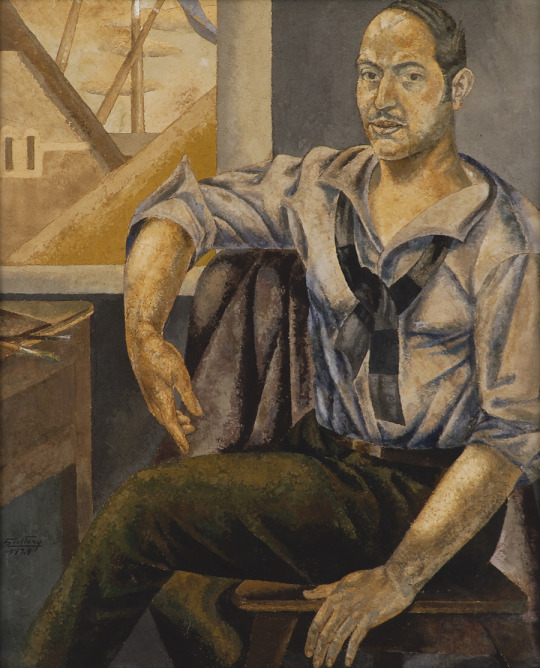
(Image Description: Retrato del pintor, Victorica, 1929 [a self portrait]. It shows Guttero in his apartment. Outside is a very geometric skyline of smokestacks, steep roofs, and a brown sky. His room is slate colored and he sits in a chair in the foreground. He has a jacket thrown over the back of his chair. His pose is casual and he looks as if we [the viewer] have just distracted him from painting. He sits with his legs to one side, turned almost unnaturally toward the viewer. One leg is lifted slightly and one hand is on the chair's seat as if he is in the middle of turning completely to the viewer. He is a man with a receding hairline and a high forehead. He has a dark mustache and dark hair and low eyebrows. He is wearing a white shirt and bowtie and has his sleeves rolled up to the elbow and his collar is ruffled and loosened. The whole thing hangs very loose but you can still see some of his body's lines of musculature. His tie undone and hanging around his neck. His pants are ordinary and green/brown. His expression is calm but confident and he looks directly at the viewer. The colors are bold but not really bright. The style blends geometry and flatness and realism in a way I am explaining very poorly. End ID)
Guttero is not terribly well remembered today, which is too bad. Looking through his oeuvre I quite like his work. Maybe it is because he lacked the bombastic personality of many modernist artists, maybe it is due to his diversity of styles without one that seems to define his work, or maybe it is because he was one of so many talented artists of his generation. He was well renown in his era, however, and used his popularity and skill to foster the next generation of Argentinian artists.
Guttero's life began mundanely enough. He always loved art, appreciating it and creating it, but pursued a legal career instead. But he was unhappy with his life as a lawyer, so Guttero left it to become a painter. He pursued his dream and passion, inspired and pushed by other Argentine artists. In 1904 his reputation was good enough that the Argentinian government sponsored his move to Paris, then the epicenter of the truly exciting and revolutionary art world, its influence expanding outward. He studied there for a few years under Maurice Denis before appearing in the Salon.
He remained in Paris until 1916 when he began to travel extensively across Western Europe for more than a decade, first to Spain, then Germany, Austria, and beyond. He traveled to nearly every country in the area between the years of 1916 and 1927. His work was shown in various exhibitions around the continent from being featured in the Salon in Paris to a major solo exhibition in Genoa.
After that he returned to Argentina for the first time since his initial departure in 1904. Guttero remained active in his native country including creating free art classes called, aptly enough, Cursos Libres de Arte Plástico, with other Argentine artists. During this time he focused on his work as an art promotor, perhaps even more than his own art. During this time he introduced and showed new Argentinian artists to a wider audience. Indeed he created an organization for this purpose: the Hall of Modern Painters. He was dedicated to promoting and preserving modern art in the face of a world growing increasingly dark and reactionary. He died young and without much warning.
His art is undeniably modernist but trickier to pin to a specific movement. He has many different styles he utilizes with different degrees of naturalism and curves vs geometry. His scenes are by and large mundane and human, he uses bright colors, often huge central subjects, kinetic poses and positions, modern settings, and by and large human or urban subjects. He often painted on plaster using a "cooked plaster" technique of his own devising.
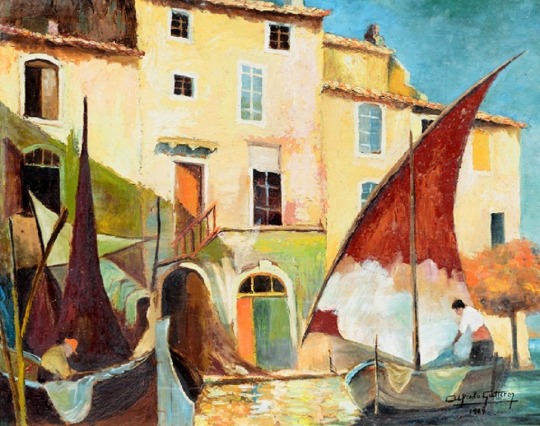
(Image Description: Martigues for Charles Jacques [1909], a brightly colored painting showing a scene in a Martigues canal. It is not completely realistic nor completely geometric and abstract. He favors color over outlines. In the background is a bright blue sky interrupted by yellow buildings with tile roofs, maybe houses, lit by the unseen sun. One of the building's lower doors is open. There is a small tree to the far right. In the foreground in the sparkling water of the canal are several small work boats, probably fishing boats judging by the silvery nets lying over the hulls. On the right a boat is coming in, there is a pale skinned, dark haired man working on one of the nets. His sail is red and white. On the left is a pale man in an orange hat and yellow shirt. He is stooped and just by his pose appears older, both of the men are too far away for many identifying details. End ID)
Possible Orientation: Mspec ace, gay ace, or aroace with an aesthetic attraction to multiple genders. (I am so unsure I have changed "probable" to "possible.")
I admit this one is a stretch on my part.
I am classifying Guttero based largely on absence, i.e. the absence of a remembered/recorded spouse, sexual/romantic partner, or liasian. I have no quotes or historical documents to prove my point. I have none of his personal philosophy or writings to draw from. Just the fact that he dedicated his life to art more than human relationshipa. That this is something I have seen before: Cause and its role in the life of many aros/aces/aroaces (outlined in Weil's entry the other day) and the fact that he had no recorded romantic/sexual partners that I can find in hours of research.
This illustrates why it is so, so difficult to find aspecs in history. We are not, as aphobes believe, impossible to locate, there is externally visible evidence, but it is less obvious than most other orientations. And cishets would rather we didn't exist so we are often buried under excuses. The easiest ways to find them are 1) if they were notably "married to their job" in their lifetimes (e.g. Jeanette Rankin and Carter Woodson), they talked/wrote about it in some capacity (e.g. T.E. Lawrence or Frédéric Chopin), they were distrusted because of it (John Ruskin and James Barrie), they made it part of their persona (Nikola Tesla and Florence Nightingale), aside from that I really need to search deep into their personal lives. Information not always available.
And often even when people essentially say "I am aromantic and/or asexual" the general population will not accept that. After all Newton is often remembered as allo and gay, despite never expressing interest in men. Chopin is often listed as allo and bi. Rankin is often considered cishet but too deeply concerned with her work. Barrie gets called a pedophile despite showing no interest in children. For eccentric aspecs like Weil/Tesla/etc. their being aspec becomes part of their oddness. If they weren't Like That they would be allo. Their being aspec becomes a symptom of their weirdness and would be unacceptable in a "normal" person.
History with a capital H does not want to acknowledge aspecs and, as with other queer identities, will go to insane measures to erase them. But even other queer historians will do this to aspecs. I am shocked how many people do exactly to Newton/Lewis/and the like what cishet historians do to Alexander the Great. In the case of Alexander the cishets ignore the obvious accounts that he loved Hephestian in nearly every way possible and queer historians and history buffs call them out, then often the non-aspec ones look at Newton and Lewis who had no interest in men and say they must have been gay. And it isn't really just history, Tim Gunn is by his own admission both gay and ace and the second part of that statement is either erased or, even crazier, I have seen aphobes say that he is mistaken about his own identity.
Anyway the root cause of this lack of nuance in the discussion of sexual orientation is a long sidebar that this is not the place to explore. I have left Guttero behind paragraphs ago. I have written a lot about how aces and aros end up getting erased from history and this isn't about that.
This is about Guttero and the difficulty of finding aros and aces. The presence of something is so much easier to find than the alternative, obviously, like if Historical Figure X exclusively slept with/courted men and was a man we can say he was (most likely) gay. But if Historical Figure Y didn't sleep with anyone/court anyone it is harder to prove. This is obviously severely simplifying identity but for the purposes of this example I beg your apology.
Long Story Short: the absence of evidence of something is not proof of the absence of something. A lot of aphobes will point this out and utterly ignore the fact that sometimes it is.
So, Guttero. The only thing I can say conclusively is that he never married and he was romantically or sexually tied to anyone as far as I can find. He was, in his time, very active in the art world. If he had been involved someone would probably have taken note. Especially considering his art is often very appreciative of the human form, especially the male one, it would not be hard to believe he was allo and gay or mspec.
I am going to take his art another way putting some dusty analysis/critique/art history skills to good use. Here's the thing, those who follow me on my personal blog or even here know I find the Death of the Author extremely important but it is also extremely complicated (it was actually the topic of my senior thesis). I don't want to use an artist's work to talk about their personal lives because art is often not reflective of life, but there is always some cross contamination in one way or another. I am going to explain what I mean on a superficial level, using myself as an example so I can say this is 100% accurate. I love the found family trope, and I think those relationships are the best in the world. So whenever I write something you can be damned sure if I can get some found family goodness in there I will. What I am saying is, I don't love or even approve of everything I write about, but I do write about some things because I love them and want to explore them and experience them on some level. The same may be true for Guttero and the subjects he painted.
Guttero often pays a lot of attention to human form. Look at his work The Market (I couldn't find a large enough image to put it in this post) and you will see his appreciation for amab musculature and on the other side of the male spectrum...

(image description: Retrato de Lucien Cavarry [1911] It shows a thin, lanky, and well dressed young man reclining on a green floral patterned couch and a black pillow. He is pale with neat, dark hair. He has a shadow of 5 o'clock shadow on his super hero jaw. His suit is white, his slightly rumpled tie is black, as are his socks and polished shoes. One arm is across the back of the couch and a red and gold pillow the other is dangling. This style is very different from the other portraits I showed/referenced. Still a modern but more realistic style, more flowing, less geometric. The man is drop dead gorgeous by Western beauty standards. End ID)
As for women...he seems to find them colder, more distant, but there is still a physical appreciation there. (Linking Mujeres Indolentes so I don't get flagged for "female presenting nipples" or whatever Tumblr's BS is. [The name alone tells you a lot]). Or the somewhat judgemental gaze of the woman below:
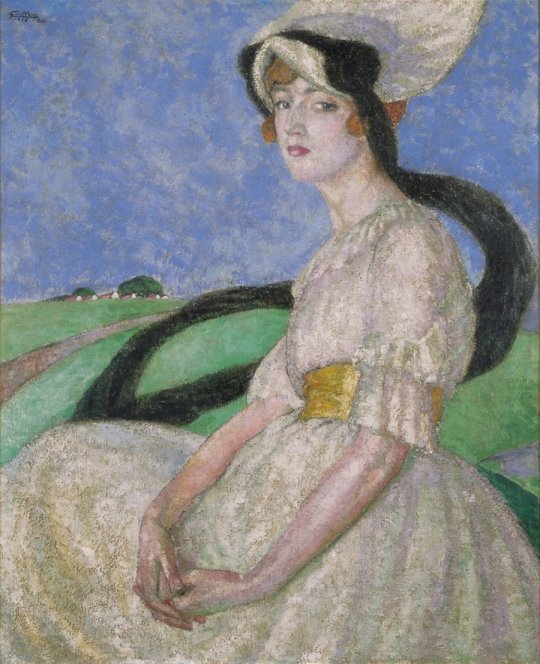
(Image Description: Georgelina. It shows a portrait of a pretty young woman sitting in front of a field. She is pale and long and beautiful. She has red hair, sharp eyes, a long flowing white dress with a gold sash around her waist, and a white hat with a black bow that is blowing in the wind. She takes up most of the frame and her expression is challenging and she holds eye contact with the viewer. The colors are bright and she is almost porciline in color. The background is mostly flat planes of color. In style it is somewhere between the self portrait and the portrait of Cavarry. End ID.)
Not all of his portraits of women have them so sour/distant but they all have a sort of challenging look. Beauty tinged with something dangerous, while the men always seem more innocent.
So here is why I say aspec rather than allo using his work alone, none of his work is particularly sexually inviting even with the sexiness/physical European attractiveness. The men are bashful or unaware of the viewer, the women are certainly not interested.
And back to the self portrait at the top: Guttero is in a fairly sexy pose, but it is sexy without being sexual. He is rumpled but the thing he was doing was painting, there is a sexless explanation. He is looking at the viewer, but you are distracting him from working. At first glance I thought his legs were spread, but they are simply in motion so he can face his guest more comfortably. This all could mean nothing, but I found it striking that this is how he chose to depict himself, at first he appears to be inviting the viewer in for a more physical interaction, but then it seems he is doing exactly the opposite, his passionate energy has been instead put into painting.
And in reality toward the end of his life that was what he did. He dedicated himself to his own art and the art of others.
So again, this could mean nothing. But...it could mean he is aspec.
And that is how the person I am least sure about got the longest entry.

(image description: Elevadores [1928]. A painting showing a factory complex. There is a raised platform running around it and several buildings in bright colors. There is a tree to the right side and a green hill. The building in the near-center [lightly left] is red. The sky is yellow and blue, perhaps the unseen sun is rising up behind the right-hand buildings. In style it is mostly geometric and flat color. End ID.)
#queer#lgbtq#asexual#ace#history#aromantic#aro#gay#mspec#20th century#artists#south america#Argentina#Argentinian#Alfredo Guttero
15 notes
·
View notes
Text
Hymnstoke XIV
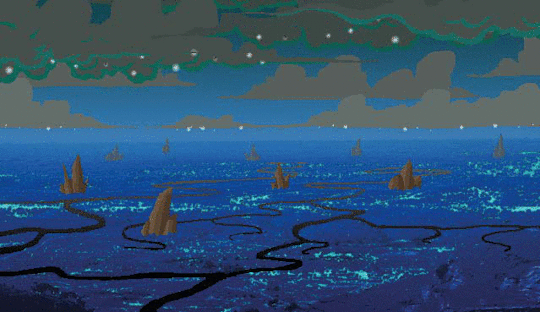
Like Act 2, Act 4 opens with a walkaround game.
I didn't comment much on the game at the beginning of Act 2, despite it being one of those much-discussed multimedia elements that make Homestuck so distinctive. In Act 2, the movement from linear story to game serves several purposes. First, it demonstrates an increase in scope, both in terms of Homestuck's story and in relation to Hussie's previous effort, Problem Sleuth. While Act 1 incorporated a couple of new elements not seen in other MSPA comics, such as protagonists capable of speech and a handful of simple videos, the Act 2 walkaround is the first dramatic increase in what readers could have reasonably expected from the comic at the time.
Secondly, the novel concept of incorporating a game into the story corresponds to and emphasizes the novel concept of SBURB within the narrative of Homestuck. Just as the world in which John now finds himself is completely new and unexpected, so too are the readers introduced to this world through a new and unexpected medium. This world is even called the "Medium"—and surrounding a space (Skaia) described as a crucible of pure creation. I previously discussed the significance of SBURB's geography in regards to Gnosticism, but one could also interpret it as a statement on Homestuck as a creative enterprise. A crucible of pure creation through which a new world, or a new mode of expression, will be built. Like how John and friends attempt to create a new world from the fragments of the old, Hussie creates a new kind of story from the fragments of all types of storytelling that came before it. Image, text, video, sound, game—Homestuck strings together these disparate modes of expression into an original creation. In short, the method by which Homestuck is presented mirrors its explicit thematic content.
Wikipedia defines phenomenology as "the philosophical study of the structures of experience and consciousness." Remember how I mentioned that the modernists were often concerned with the conscious and subconscious, and how many attempted to reach truth by depicting the subconscious? Similar concept here.
I was introduced to the term "phenomenology" in relation to art history. In particular, my professor applied the term to modernist painting and sculpture that was designed so that the act of experiencing it changes its meaning. Let's take the following sculpture:
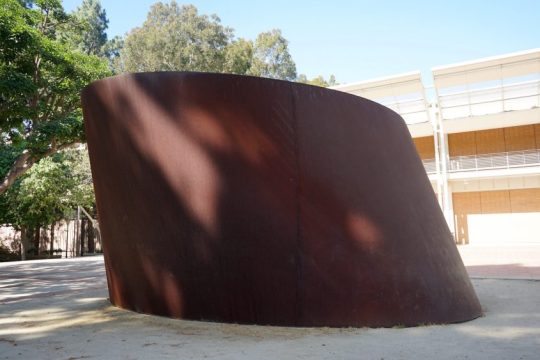
"Sculpture?" you may ask. Yes, I know. It looks more like a misshapen industrial structure. The problem with this sculpture is that no single photograph can truly depict it. Here's the same sculpture from a different vantage:

Another:

Still another:

Top down:

Is this sculpture broader at the bottom or at the top? What shape is it, exactly? You can find this sculpture at the University of California, Los Angeles, and you can even go inside it through the opening visible in some of the photographs. Inside, it takes on a completely different appearance, although unfortunately I couldn't find any good pictures of the inside that didn't have a gigantic Getty Images watermark on them.
In art, this phenomenological experience often boils down to optical illusion or a similar technical trick that appears novel at first but lacks much substance beyond its presentation. What meaning can we derive from this experiment or others like it?
I believe that the phenomenological creations of the modernists eventually reached an apotheosis in a more contemporary form of creative expression: Video games.
The way the player perceives a video game, even a video game you might consider simplistic or linear, is directly affected by how the player plays the game. Take, say, Super Mario Bros. (1985) for the Nintendo Entertainment System. In this game, the player moves Mario left to right to reach a fixed goal. But even this game is affected immensely by the innumerable choices each player makes in playing the game. For an extreme example, compare how a speed run of Super Mario Bros. looks compared to any casual experience of the game. Some elements of the speed run even involve elements assuredly not intended by the game's creator (glitches, for instance). But even at a less extreme level, every player's experience of Super Mario Bros. will differ depending on the routes they take to reach the end, the strategies they employ to evade obstacles, or even the amount of times they die before finally succeeding.
Why do I bring this up? The concept of phenomenology ties into Homestuck's "reader participation" elements, both via the prompt suggestions early on and the more psychological effect the fandom has on Homestuck's development in its back half. Of these two "reader participation" elements, the latter is the one that is probably better described as "phenomenological," in that it is the readership's perspective of Homestuck that eventually drives its trajectory (as opposed to the prompt suggestions, from which Hussie could pick and choose at will). In the back half of Homestuck, the narrative plays more and more on the author's interpretation of the readership's interpretation of the narrative, becoming a perspectival mobius double reach-around where the true driver of the narrative's creation becomes increasingly unclear.
But more specifically, I want to discuss this walkaround game at the beginning of Act 4 in particular. Compared to the one at the beginning of Act 2, this walkaround is not increasing Homestuck's scope. John is entering a new location, but the experience is less novel than entering the Medium in Act 2, both in terms of John's perspective and the reader's. While the Act 4 walkaround features mechanical improvements (inventory, combat) over the Act 2 walkaround, it is still essentially the same thing: a video game. The reader has seen this before in Homestuck. It's not new.
I cannot speak for the experience of every reader, but each time I read Homestuck I am tempted to skip this walkaround entirely. The combat mechanics are banal, the camera is zoomed too close to John to allow for satisfying exploration of an unfamiliar world. In Act 2, the walkaround takes place in an area with which the reader is already geographically acquainted (John's house), so the camera issues are less apparent. But trying to navigate this twisting maze of blue paths, surrounded on all sides by nondescript rocks and mushrooms, can become frustrating. Even if I consult the supplementary map image, I find it somewhat difficult to figure out where I am and where I'm supposed to go.
Which is just the thing. The reader is not supposed to go anywhere. There is no real resolution to this walkaround. The same, in fact, can be said for every walkaround, and we will continue to get amazingly nonessential walkarounds in the acts to come. What does the reader miss if they skip this Act 4 walkaround? Some tedious exposition on the nature of John's planet, its consorts, its customs. Superfluous W O R L D B U I L D I N G that the Homestuck narrative is quick to forget from henceforth on.
It kind of makes me want to, shall we say, skip to the end.
In Act 5, Vriska and Tavros will discuss how the way one plays a game affects the way the game is perceived. Hardcore speed runner Vriska will take my side of the argument and skip what she can; Tavros, more in line with readers inclined to learn as much about SBURB's lore as possible, will argue instead for assiduously completing every task. This conflict—between speed and lore, content and fluff, meat and candy if you will—eventually becomes the core and final dichotomy of Homestuck. But in Homestuck's later stages, the characters and narrative will apply this dichotomy not to how we experience video games, but how we experience all art—and how we experience our actual lives. I intend to trace that development, and this walkaround serves as a fine introduction.
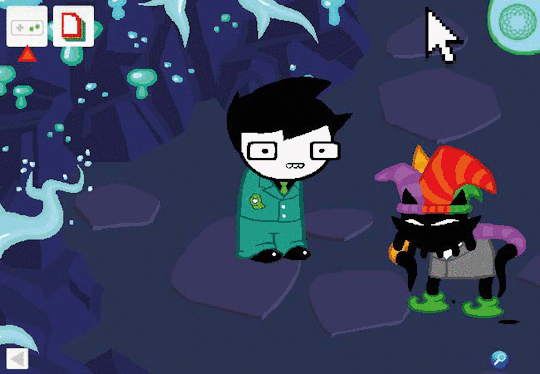
In a few years, Flash will be deprecated and you'll only be able to experience this walkaround through this series of images. I don't know who created these images, or whether laziness or incompetency made them so shitty and SBaHJ-esque. But I give that person props for maintaining that sense of "God this sucks, can I just skip it?" Good job, intern.

You switch to PICTIONARY, a choice based on a strong whim from the mysterious ethers of democracy.
Another one of those traps, like the suggestion prompts. Wow! The readers get to pick Jade's fetch modus! What an amazing display of reader/author interaction! Except Jade's fetch modus doesn't matter. In fact, as we transition into this next phase of the story, nobody's fetch modus will matter. The fact that all of Jade's possible fetch modii are total jokes only emphasizes the point.
I mentioned in the previous Hymnstoke that we're entering what I'm calling the "clockwork" part of Homestuck. In this part, Homestuck's audience has the least amount of control over its progression. While the suggestion prompts were mostly irrelevant because Hussie could pick whatever prompt he wanted, they occasionally paved actual story or character developments ("Become the mayor of Can Town") or formed memetic jokes that would mutate over the course of Homestuck into part of its mythos. And in Act 6, the immensity of the Homestuck fandom and its increasingly vocal demands will lead to a more subtle transition in what Homestuck becomes—the mobius double reach-around I mentioned previously. But here, in the clockwork part of the story, it's more Hussie than anywhere else. Of course it would be. It's Dirk, Hussie's analogue (connected via a series of motifs like horses and robotics), that comes to represent the Meat side of storytelling, that describes the way a story should be told as a perfect machine. An unfocused, nebulous gaggle of "readers" cannot hope to coordinate among themselves to create something so precise and efficient. Their strengths lie in different directions.

Ok, have at it! If you're at a loss, click the controller button up there.
This may or may not mean anything to you depending on your current perspective.
As it turns out, the story retreads everything that happens in the Act 4 walkaround anyway, making it even less relevant. Even Crumplehat and the Salamander Wizard appear as the walkaround's events are depicted from PM's perspective. This recap is actually pretty extensive, similar to the shitty SBaHJified image walkthrough that got put up in anticipation of Flash's deprecation.
I wonder if Hussie was self-conscious about people's patience for the walkaround? Or maybe he already anticipated Flash would not last forever? Perhaps he added this recap for accessibility reasons, in case of visually-impaired readers? Maybe he felt some new insight would come from seeing the same events replicated from a different character's viewpoint? Or maybe he simply wanted to reveal that the person speaking to John during the walkaround was PM instead of WV?
I'm doing exactly what I said I wouldn't do and trying to delve into Hussie's psyche. As it stands, the addition of this recap makes certain elements of the walkaround mandatory experiences for the reader to progress, as opposed to the walkaround itself which can be ended without experiencing anything. I'll leave the discussion by reiterating the second part of the quoted text:
This may or may not mean anything to you depending on your current perspective.
And I think it's safe to say our "current perspective" is much different than those who read this first.
13 notes
·
View notes
Text
Intertextuality: In the life of the Kardashians
Writing is one of humankind's most primal methodologies of dissemination of information and communication. Cavemen (and women) used a type of symbolic writing, known as ‘pictographs’, to display drawings of the animals they hunted as well as the ceremonies they would partake in. Despite ‘pictographs’ not entirely embodying the writing we know now, the 40-50,000 BC scripture triggered the movement towards alphabetic interaction.
Moving slightly further ahead in time, the increasing accessibility for reading and writing materials began the evolution of technology. Charles Babbage introduced the world to digitalised media in the early 1800s when he constructed a machine which would solve his problems of calculations in mathematics. The introduction to ‘machine-readable formats’ was, unbeknown to Babbage, the beginning of a globalised phenomenon relied on by millions - but not for the same numeric calculations it was once intended for...
Inventions such as the Smartphone, have broadened our abilities to consume and access information. Since Primary School, I can remember delving into the realms of digital media platforms from as early as 7 years old. Children are brought up with access to phones, iPads and laptops for entertainment, educational and distraction purposes - so nowadays when eating at your favourite restaurant in town, there is no longer an element of shock when spectating a nearby family with children all scrolling and tapping on seperate devices during their meal, due to the normality and natural occurrence of digitalisation. Our exposure to technology is so profuse that even babies are now taken on buses with iPads shoved under their noses, with the latest episode of Peppa Pig, whilst their mum sits scrolling through Facebook.

The point is, we are all so exposed to the instantaneity of devices that we are losing touch with the connectedness and sentimentality with the true mediums of word. Newspaper articles are no longer desired as a tangible purchase because now, with a few taps on a screen, we can receive the latest news updates on our phones or tablets. Subsequently, the purchasing of hardback books are in a general global decline, reporting to have decreased by 3.4% in 2018 defined by the influx of the digital alternative, the Kindle, experiencing sales between 20 to 90 million over the course of the last decade (Amazon). The concept of a technological takeover suggests that consumers are favouring the practical and transportable methods of reading over the traditional process of turning a page.
In addition’, the crave for platforms which require the least effort suggests the presence of a lazy generation. Instead of having to search through a library to find a suitably informative book, the internet has allowed for access to instantaneous facts and figures provided and suggested to you. Google is the most actively used search engine with 3.5 billion searches per day. This method of consuming information outlines a contagious dependency which we ALL rely on for immediate gratification - this is rather than reaching for a book, requiring incomparably more effort to gage the desired information. Through the accessibility to the internet, digital media has allowed for the growth of knowledge and intellect, such as the input of a read-write web. Most apps downloadable on tablets rely on the concept of expression for users to exercise its domains to suit their requirements. For example, Twitter allows for users to post and interact their thoughts and feelings within the conversational networking site, but in some cases, the app may be used by one person as a freedom of speech and for another it could be used for a less self-indulgent platform - like job searching or news articles through the connectivity of a #hashtag.

In basic terms, we all roam the domains of the internet with different intentions and yet we can all identify with the purpose to either share, support or be inspired by our searched information. The internet is a space for consumption, growth and reflection caused by the involvement we are now provided with when being able to influence online content. The internet provides a variety of input through the ability to share and comment on sites inviting feedback. Despite this being an invitation towards intellectual and challenging conversations made more approachable through online networking and connectedness, it can also be manipulated by critics and trolls seeking to implode judgement on unsuspecting individuals. The freedom of a read-write web has been recently made into a potentially dangerous world of forced judgement and unexplainable hatred by mostly anonymous and fake accounts.
Due to the globalisation of the internet, such outcomes as intertextuality have evolved as a product of the progression in the lack of unique content (often receiving negative backlash). Intertextuality allows for repetition and relational material to be understood as a complimentary embodiment of an original, featuring and interpreting artworks of differentiability or historicality. With the internet now 45 years young, activated in 1969, it is unlikely that the content discoverable nowadays hasn’t been neither influenced nor inspired by anaphoric textuality. This has made public figures less admirable when their work is comparable to previous editions - intentional or not. Cases of intertextuality are common simply due to the earth being old. Bluntly, it is 4.543 billion years old so the assumption that content created nowadays is unique and never been done before, is impossible. The difference is that now - with the permanence of online sources - we can refer to previous postings to consider reconstructions as examples of either intertextuality, the remix culture or just plain copyright.

To demonstrate intertextuality, I feel it’s justifiable to use the Kardashian-Jenner family as a true modernist representation due to their constant presence in the media. The Kardashians are undoubtedly one of the most influential families in the world so therefore impact a lot of online media coverage. With the concept of intertextuality proclaiming as a hot topic in their recent years of fame, certain Kardashian members have demonstrated the extreme reactions provoked when photoshoots and campaigns merely infer historicality. Their gross level of fame make it difficult to decide whether the headlines attached to certain articles are justifiable, like does it provoke the legitimate shock factor? Or is it simply just an opportunistic platform for critics to slander the Kardashians once again for no reason whatsoever? The problems arise when intertextuality is no longer received as a complementation of inspiration, but rather proof of a lack of imagination and injustice to the original structure.
So let’s begin.
Kendall Jenner. Racist? Or just an unfortunate victim of an intertextual failure? Not many of us might recognise her campaign with Pepsi-cola, as it was pulled from tv after only 24 hours due to the outrage and dismay caused amongst the public. The advert saw Kendall abandon her fashion shoot when a protest catches her eye, so randomly decides to approach one of the more attractive police officers by handing him a bottle of Pepsi - as you do. When the advert aired, viewers complained about the uncanny resemblance between the Pepsi ‘Live For Now’ ad and both the Black Lives Matter movement and the 1960 Civil Rights Marches.

Now, it could be suggested that there isn’t much similarity between the Pepsi campaign and the Civil Rights movement, nor does the peace offering of a Pepsi can hold much resemblance to the marches activated almost 6 decades previous to Jenners acting debut. However, when considering the bigger picture of the intertextual nature of the campaign (almost certainly inspired by the concept of the Civil Rights protests) the influence upon the storyline of the advert is undeniable. Due to the reinvention of the iconic movement which helped shape history for black Americans, it is not surprising that the reception of a supremely white female fixing a protest due to a can of Pepsi infuses an element of mockery within the intertextualisation between the two events. Black Rights campaigners such as Color of Change, an American group that campaigns to “end practices that unfairly hold Black people back,” branding online that Kendall’s actions “appropriated our pain and struggle” which was implied due to the similarity of settings.
I mean, Kendall Jenner might not be a racist and I’m not insinuating that she is but the branding of the Pepsi-cola campaign certainly raises a few eyebrows for what she actually expected to happen after mocking history.
The reception of intertextuality is determined by the viewing public and relies on their interpretations and overall power. Despite the creative process being intended as an aesthetically pleasing representation of an original artwork and rather paying tribute than mocking or redirecting it’s initial intentions, the line between a well received repetition of a construct and one that is not, often hangs in the balance of the finer details. To explore this let’s use the mishaps of another Kardashian.
Here we go again...

Kim Kardashian West. Arguably the most famous Kardashian due to her inability to stay out of the public eye for more than five minutes. She married a famous rap artist and then proceeded to have 3 beautiful children, so it was only a matter of time before she shoved one of them in front of the camera. At the age of 5, North West has already posed alongside Kim as they channelled America’s late First Lady, Jackie Kennedy Onassis, for an interview and magazine shoot. When addressing the influence of Kennedy on the Kardashian, it’s assumptive that Kims desire to imitate a stronger and more desirable individual as the images create relationships and forges likenesses between herself and the First Lady. North West’s inclusion exercises the freedom of intertextuality as the photoshoot takes inspiration from a public figure and aims to deploy an interpretation instead of copying their exact iconic images. The photoshoot of Kim Kardashian West and her daughter embody the relativity between Jackie Kennedy’s appearance but engages intertexualisation when capturing the style of Kennedy through their own style of expression.
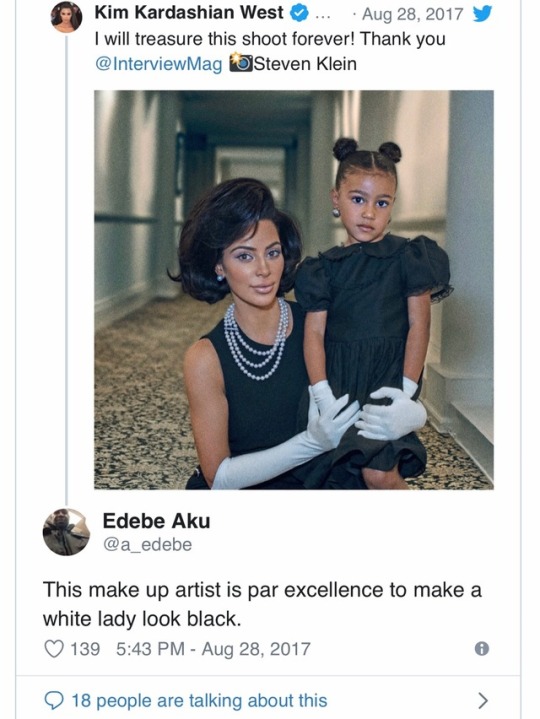
When cross-examining the impact of a read-write web and the growing influence of intertextuality, the Kardashian/Kennedy photoshoot demonstrates how it can all go so wrong. When the shoot was published the hype it created was nothing to do with the beauty and charm of the images, but surrounding the Kardashian herself somewhat altering her appearance to match her daughters. It is no surprise when looking at the Kardashian clan, that their figures are not only arguably more curvaceous than your average white woman but also the rapid progression of their hourglass shapes developing unnaturally fast. Despite the obvious bum implants, rib-removal and liposuction of the middle Kardashian, it was her ‘black facing’ that made the internet go crazy and begin to brand the family as ‘culture vultures’. Caused by the accessibility of the public to retweet, share and publish their opinions online, it comes as no surprise that celebrities are at the full front of the darker side of the internet, especially when Tweeters and Facebookers can attach previous slip ups of the same individual to provide a stronger attack through public shaming.
Intertextuality is a factor of which the Kardashian-Jenner family rely on for most of their inspiration. It’s not unusual though. Like many other public figures or influencers, their ideas all derive from something which previously triggered them to create their next clothing line or the storyline behind the lyrics of their new song. Most intertextual pathways for celebrities are financially motivated with the intention to impact the public, whether it be a new trend copied by fans or solely for the purpose of humour. The humour derived most recently, through the use of intertextuality, is Celeste Barber, an Instagram Comedian whose account blew up when she started recreating images of top models to entertain her followers and encourage a new platform of body confidence.

5 notes
·
View notes
Text
the shaded hollows
‘To persons standing alone on a hill during a clear midnight such as this, the roll of the world eastward is almost a palpable movement. The sensation may be caused by the panoramic glide of the stars past earthly objects, which is perceptible in a few minutes of stillness, or by the better outlook upon space that a hill affords, or by the wind, or by the solitude; but whatever be its origin, the impression of riding along is vivid and abiding. The poetry of motion is a phrase much in use, and to enjoy the epic form of that gratification it is necessary to stand on a hill at a small hour of the night, and, having first expanded with a sense of difference from the mass of civilised mankind, who are dreamwrapt and disregardful of all such proceedings at this time, long and quietly watch your stately progress through the stars. After such a nocturnal reconnoitre it is hard to get back to earth, and to believe that the consciousness of such majestic speeding is derived from a tiny human frame.’
I read another Thomas Hardy novel, not long after my first. I can’t be entirely sure why — I liked The Mayor of Casterbridge quite a bit, but it wasn’t the kind of book that instantly promotes its author to a top ranking in my mind. I think it might suffice to say that I enjoyed the feeling of reading it more than I thought it was an exceptional novel. I’ve now read Far From the Madding Crowd, however, which has probably cured me of my past notion, because I enjoyed it a good deal less.
The plot is, like most over-encumbered stories, best summarised quickly. Bathsheba Everdeen is a local woman who has come into the ownership of her own farm; Gabriel Oak is a well-read young shepherd with ambitions towards independence; Boldwood is a wealthy local farmer. After certain misunderstandings and outpourings a love triangle of sorts emerges between these three, and is interrupted by the shameless figure of Captain Troy, a dashing and not infrequently ridiculous officer in the army. Bathsheba falls for Troy, but he is cruel and stupid, and he has secrets that threaten to destroy them both.
It is a book of fine moments that barely cohere as a single narrative. I suppose it works best considered in the context of how it was originally published: as an episodic drama, not unlike a modern TV series. In that way the stark tonal shifts and shapeless plot seem to make a kind of sense. I don’t call it ‘shapeless’ only to denigrate it — I mean it only in the sense that it has no direction, drive, or symmetry. It wanders; there is no hero and heroine, really, and there is certainly no quest, no particular beginning or end to the tale told here. It might end with a marriage but it is hardly a romantic one, even though this book is somehow celebrated as a love story.
A certain sense of plotlessness, or pointlessness, is certainly part of the point, as when Captain Troy comes to realise that he is perhaps not the protagonist of his own life:
‘He had not minded the peculiarities of his birth, the vicissitudes of his life, the meteor-like uncertainty of all that related to him, because these appertained to the hero of his story, without whom there would have been no story at all for him; and it seemed to be only in the nature of things that matters would right themselves at some proper date and wind up well. This very morning the illusion completed its disappearance, and, as it were, all of a sudden, Troy hated himself. The suddenness was probably more apparent than real. A coral reef which just comes short of the ocean surface is no more to the horizon than if it had never been begun, and the mere finishing stroke is what often appears to create an event which has long been potentially an accomplished thing.’
Some of this book is barely readable. It is too long, and the last fifth or so goes off the rails entirely. It is frequently boring: there are winding sections of dialogue here which add next to nothing to the story. Bathsheba is a compelling figure haunted by a dismal spectre of authorial misogyny, while Gabriel Oak’s goodness is creaking in its contrivance. He is allowed to be both worldly and wise, to be smart and self-sufficient, and to cap it all, a human being in need of affection; Bathsheba cannot have half as much as he without floundering, always hampered by some weakness conveniently assigned to her gender.
And yet there are moments of startling brilliance here. The gap between Hardy at his worst and at his best is perhaps greater than in any other author I know. His descriptive writing, whether it touches the consciousness of his characters or the landscape of Wessex, is frequently stunning. There’s a startling beauty in his throwaway lines, like the description of Bathsheba’s hair, ‘…black in the shaded hollows of its mass’. The range of his style is remarkable: at times he comes across as an early literary impressionist, at others an even earlier modernist. One could take a quirky little passage like this and transplant it directly into Ulysses with no adjusting:
‘We turn our attention to the left-hand characteristics; which were flatness in respect of the river, verticality in respect of the wall behind it, and darkness as to both. These features made up the mass. If anything could be darker than the sky, it was the wall, and if any thing could be gloomier than the wall it was the river beneath. The indistinct summit of the facade was notched and pronged by chimneys here and there, and upon its face were faintly signified the oblong shapes of windows, though only in the upper part. Below, down to the water's edge, the flat was unbroken by hole or projection.’
At times there is almost a surfeit of style. The omniscient narrator’s mannerisms are occasionally overbearing in their verbosity. The sudden dashes between high and low registers of language seem intended to mimic Shakespeare, in their quality of making a dramatic address to the reader that iterates as it explains. Sometimes this works, and sometimes it doesn’t. Sometimes it is pleasantly droll, as when the narrator describes the fate of a dog who drove a quantity of sheep to their demise through over-enthusiastic chasing:
‘George’s son had done his work so thoroughly that he was considered too good a workman to live, and was, in fact, taken and tragically shot at twelve o'clock that same day—another instance of the untoward fate which so often attends dogs and other philosophers who follow out a train of reasoning to its logical conclusion, and attempt perfectly consistent conduct in a world made up so largely of compromise.’
Sometimes the only way to explain something is to really explain it, and so when Hardy puts on his lecturer’s hat and taps his lectern, you have to listen. The writing in the passage below is airy, abstracted, distant, and it could even be called emotionally detached by today’s standards, but the shape of the syllables and the cascading sub-clauses have a rhythm that suggests an intellect possessed by a greater music — precisely how Boldwood feels:
‘The great aids to idealisation in love were present here: occasional observation of her from a distance, and the absence of social intercourse with her—visual familiarity, oral strangeness. The smaller human elements were kept out of sight; the pettinesses that enter so largely into all earthly living and doing were disguised by the accident of lover and loved-one not being on visiting terms; and there was hardly awakened a thought in Boldwood that sorry household realities appertained to her, or that she, like all others, had moments of commonplace, when to be least plainly seen was to be most prettily remembered. Thus a mild sort of apotheosis took place in his fancy, whilst she still lived and breathed within his own horizon, a troubled creature like himself.’
And yet sometimes I still think Hardy is at his best when he hits you like a bullet:
‘When Bathsheba's figure shone upon the farmer's eyes it lighted him up as the moon lights up a great tower.’
1 note
·
View note
Photo

Talking to Jason Jules about John Simons, Patron Saint of English Ivy
In an age where everyone buys almost everything off the internet, sometimes from far-flung warehouses located in other countries, it’s easy to forget the important role certain brick-and-mortars played in shaping regional taste. These retailers, who were often small and independent haberdasheries, were the original tastemakers. Fred Seagal, for example, was once thought of as the gateway into the Los Angeles fashion market; Louis Boston introduced many to the comfort of Italian tailoring. In fact, Luciano Barbera got his start in marketing tailored clothing because of a suggestion from Murray Pearlstein, Louis Boston’s late proprietor. The two worked together to develop a line of ready-to-wear Italian suits and sport coats, which was initially aimed at the New England market.
John Simons is considered by some to be the patron saint of English Ivy for the same reasons. For the last sixty years, he’s been a steadfast evangelist for the same kind of clothes -- J. Keydge natural-shouldered jackets, Florsheim Imperial brogues, Bass penny loafers, button-down shirts, and other things Ivy. He introduced the look to English shores in the 1950s and has stuck with it ever since, proving there’s such a thing as classic style.
More importantly, he’s played an important role in shaping British taste. For almost three generations, mods, suedeheads, and skinheads (a term for a section of working class youths before the name became associated with racists) have gone to John Simons to look street-smart and well-heeled. John Simons was also the one who gave Harrington jackets their name. Originally referred to as golf jackets, Simons remembers the time when he climbed into his shop window to write on the buff-colored card attached to a store display jacket: "The Rodney Harrington Style.” It was reference to how Rodney Harrington in Peyton Place wore the same model. Now the name is everywhere.
This Monday, Mono Media is releasing a film about John Simons by Jason Jules. Some readers may recognize Jason as the face of Drake’s, but he’s also a vet in the London arts scene, having worked as a club promoter, PR rep, and fashion industry consultant. His film, titled A Modernist, is about a shop he loves, the clothing inside, and the store’s connection to culture. We sat down with Jason to talk about his film, Ivy Style, and other topics.

How did this project start?
I’ve known John’s shop since I was a kid. When it comes to Ivy Style, jazz, and modernism, John was Wikipedia before Wikipedia. Discovering his shop was a real eye opener for me. I was already into beat poetry and jazz at the time, but his shop pulled everything together. It has authenticity; it’s a place I can trust. I know if I go there with my eyes closed, pick up something from a rail in my size, it’ll always be the right thing. There’s not a single questionable item in the store.
Later, when I started making short films, it occurred to me that I should do something on John Simons. I put it off for a while, and then I heard a rumor John passed away. Thankfully, that turned out to be untrue, but the rumor kicked me into gear. What was originally supposed to be a five-minute nod to important influences in my life eventually grew into this hour-long feature on the shop and its clothes, as well the cultural attendants that came with them.
You mentioned trust. When I was a kid, I remember certain stores having an incredible amount of influence. If something was carried there, it was considered good. Do you think that’s still possible with the internet? Stores are so untethered by geography nowadays, people are constantly comparison shopping online. Loyalty seems like it’s at an all-time low.
I do, partly because I think certain stores offer a curational experience. I can walk past an art gallery, for example, and look at the work through the window. But that’s not the same as going inside and walking through the gallery, talking with the curator, and learning more about the pieces. Stores that give you a similar experience are the ones that will flourish. Think of shops such as Supreme or John Simons. Even if you go in there and get nothing but a conversation, you’ll walk out with something. You’re being exposed to a set of inherent values and taste markers that are almost too nuanced to grasp if you purely shop online.
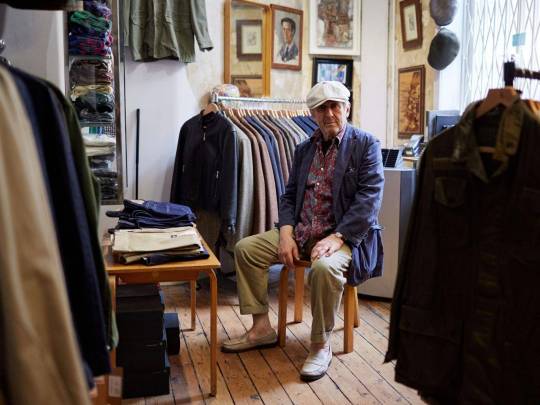

John Simons has also historically sat in the middle of some important cultural movements -- his influence on mods, skinheads, suedeheads, etc.
John has a deep understanding of clothing, and he loves sharing it with people, regardless of their background. That’s one reason why there was, and still is, such diversity among his customers. He sold to kids who were into reggae and ska, just as he sold to advertising executives. He treated everyone equally.
That wasn’t always true elsewhere. There were some stores in Mayfair or tailors on Savile Row where, if you didn’t fit a certain archetype, you may have been met with a level of resistance or snobbery. John never did that; he welcomed everyone. He was never a mod or skinhead himself, but his clothes appealed to all those people. And he had a knack for putting his store in forward facing areas. At one point, he had a shop in the Soho area of London, just as the place was becoming an advertising hub. There were film companies and advertising agencies up one way, then music venues down the other. Right in the middle was John Simons’ Squire shop, so you got business people and music fans coming into the same store, buying the same clothes.


What do you think drew mods and skinheads to these clothes?
I think the clothes meant different things to different people. I imagine skinheads and suedeheads were reacting against the hippie movement at the time. There was a sort of neatness about the look that appealed to their working class roots, but the clothes also embodied a certain aspirational element. It was looking a bit more accomplished than what your wage packet might suggest. The early mods, on the other hand, often had good jobs and they liked dressing a certain way. But the appeal was still essentially aspirational – looking a bit outward at the time, as opposed to the more insular mindset of the previous generation of kids just coming out of the war.
That kind of sounds like the story of the ‘Lo Heads.
There are some parallels. I think the thing that makes it different is that John’s shop somewhat tempered what people wore. For example, as a kid, if I went into Ralph Lauren or Harrod’s, I knew I would be followed. It was a given, regardless of what I wore. Whereas if I went to John’s shop, I knew I would be welcomed. So for me, and I’m sure a lot of people, going to alternative sources to buy something wasn’t an attractive option. John shop was always the primary source in that way. That meant you interacted with the shop as more than just a retail outlet.
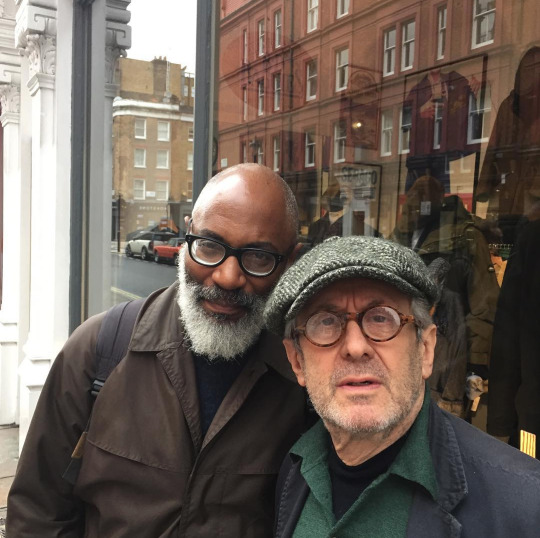
I remember in the ‘80s, I went into John’s shop to buy two Baracuta jackets. I wanted them a size too big, because that was my “look” then, and John told me the fit wasn’t right. I didn’t listen to him at the time because I was young and still finding my way with clothes, but his advice still stuck with me. The service made for a different kind of experience.
Many luxury companies back then worried about working-class people -- often ethnic minorities – wearing their clothes because they feared the association devalued their name. What made John different?
It was just the kind of people who worked in the shop. It was always about the clothes and culture. If someone showed an interest in the clothes and culture, they were eager to share their knowledge. And in many ways, they were also “outsiders.” John is a working class Jewish kid from East London. He has an outsider perspective. Some brands are protectionist, but John is an ambassador. Burberry used to vilify people who wore their check head-to-toe, but now they style their clothes the same way on the runway.
Or look at what’s happened with Dapper Dan!
Dapper Dan was public enemy number one for Gucci at one point, and now he’s hailed as the patron saint. There’s a new generation of marketing people, creative directors, and designers inside brands such as Ralph Lauren, Burberry, and Gucci that recognize the value of those outsider perspectives. John, on the other hand, has always been aware of this, so his door was always open to everyone.


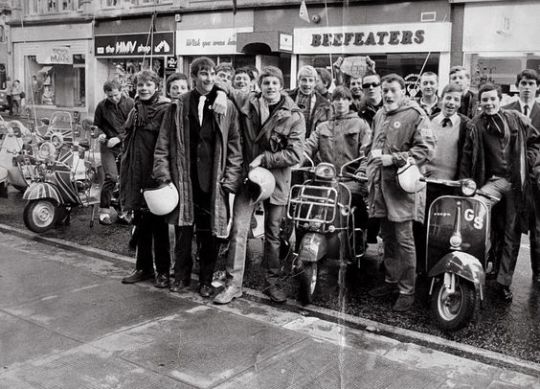
In his book Ametora, David Marx wrote about how Ivy Style became its own thing in Japan. People wore things because their cultural heroes in Japan were wearing them, not because they were trying to imitate students at Harvard or Yale. Do you feel that happened with Ivy Style in the UK?
I think that a lot of people were into it in a purely contextual and insular way. After the first wave of modernists, the style was increasingly adopted by kids who wanted to emulate a mod look, and not because they were trying to be Italians. They wore those clothes because their mates were doing it. It becomes very peer-centric, very self-referencing in that way.
For example, I was asked a few years ago how long I’ve been into Ivy. I hadn’t even realized I was into Ivy! I was into button-down shirts and loafers and flat-front trousers. I was into patch pockets and cord jackets. I was into The Graduate and Steve McQueen. I was into Blue Note Records and modern jazz. I liked a certain look that could be defined as Ivy, but for me, it had a different meaning as a kid growing up in London.
Is there still that connection between clothing and culture? The Guardian had an article about how, fifty years ago, you could tell if someone was a mod, punk, hippie, goth, or soulboy from the way they dressed, but that’s harder now since so many people follow the same trends. Are there still youth subcultures that can be identified by the way they dress?
I think there are, but things move so quickly now, it’s hard to recognize something as peripheral. Like, Palace Skateboards used to be super niche five or six years ago. It was just a group of kids making t-shirts and crazy skateboard videos. Now they’re all over the place, and it’s easy to forget they came out of an incredibly small subculture.


Or look at Tyler the Creator and his line, Golf Wang. That originally came out of a subculture and the mainstream didn’t mess with it because they considered the line too obscure, too wild, too odd. Now they’re embraced like latter-day rockstars. It’s just that this transition happens so quickly now, it feels like things can become mainstream almost overnight. But the people behind these things were part of a subculture at one point.
Another brand like this is Trapstar. They started as kids who liked A Bathing Ape, but wanted something more local. They were West London kids who threw parties in other people’s shops and made incredibly high-spec’d t-shirts. They’re very authentic to London streetwear culture, but now their product is being sold internationally and sported by mainstream stars such as Rihanna.
Do you think the internet has homogenized or diversified culture?
I think it’s done both. It’s allowed people to find their own voice and realize there’s a community somewhere that will respond to them without any filter. But there’s also a lot of people who want to be part of a homogenous, mainstream culture. The internet allows for both of those things. I also think we all have both these elements in us. I like pop music, but also weird jazz. I watch Netflix, but also obscure films. The internet allows us to explore both these sides of ourselves, so they can happily co-exist.
Heritage clothing was really big five or six years ago, and now it feels like things have moved on. Is it harder to market this type of film now?
There was a point in the heritage movement where people thought there was a genuine shift in consciousness, that people would always buy less, buy better. Heritage turned out to be a trend, but it was an important trend. I’m not sure what happened, but like you say there was a palpable move away from what was essentially a style of clothing built around nostalgia. What remains of the trend, however, is a heightened appreciation of quality and craft, as well as a new kind of language, which we can apply to everything.

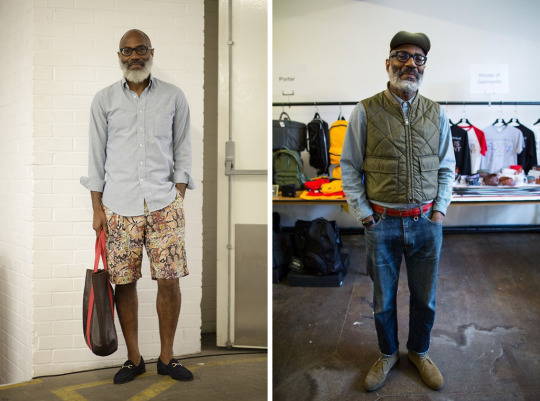
If you look at people who are into sportswear right now, they still talk about how things are made – the weight of the fabric on a t-shirt, how the print is applied. It’s no longer weird to talk about how denim was woven. Even sales assistants in high-street stores want to tell you how a pair of jeans was made.
So, in some ways, it’s become easier to talk about a clothing style that’s been around for more than fifty years. Mainstream journalists don’t look at you funny anymore if you describe your clothes as “Ivy.” At the same time, the social network for this stuff is a little more diffuse, but the people who really appreciate classic clothing will always appreciate it.
Do you think Ivy is ever going to come back in the way it did ten years ago?
I don’t know, but it’s like when the heritage thing was in full swing. Someone asked if I was pissed because all these people were dressing like me. “You’re looking like a trendy!,” they said. I said it’s fine because their interest in Ivy and Americana is a passing thing, for the majority of them, while I’m stuck in this. There will always be enough of us to have a community. This film isn’t for everyone, just as John’s shop isn’t. They’re for people who get it. For me, Ivy never went.
When I look at John Simons’ shop, it strikes me how the same clothes can look different in the UK than they do in the US. You mentioned the diversity among John’s customers, his acceptance and even embracement of others. At the same time, here in the US, Ivy style has lost some of its charm.
Part of that is because some members of the alt-right have picked up Ivy. The other part is how it’s become harder to ignore the uglier associations with the style. My co-writer Pete put it well a few years ago when he said “prep implies privilege and inherited money; some of prep’s charm comes from the unquestioning self confidence bestowed only by independent wealth.” The 1950s boarding schools and universities that originally made Ivy appealing are also the same places that discriminated against minorities around the same period.

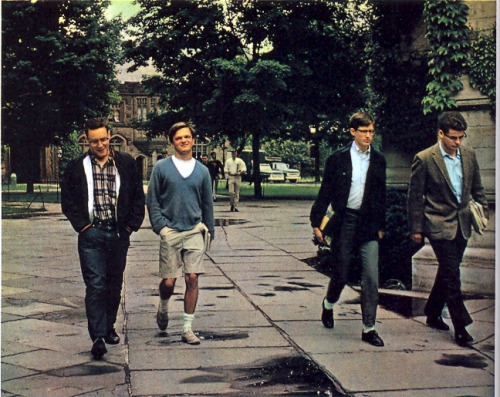
Yet, in the UK, these clothes don’t feel like they have that baggage -- at least in the way they’re presented at John Simons. They have a different feel, much more modern and even democratic.
I know what you mean. For me, wearing these clothes, I always felt like I was in the process of subverting something. Even if it was just what it means to be a black kid growing up in London, being the only kid in the classroom wearing a button-down shirt. It was about subverting something that’s not supposed to be for you. But in some places, the look has been recast as the uniform of a social and economic elite. It’s harder to ignore how some people are not just taking advantage of their privilege, but even flaunting it.
Sometimes I think the heritage movement is partly connected to where we are now. I remember looking at a really important blog during that period, and they had a list of American-made products, authentic American brands. There were fifty to a hundred brands on that list, everyone from Pendleton to Woolrich, but none of them were Native American. I remember thinking it was so strange. We’re buying into something inclusive and liberating, but there’s also something nebulous around the edges. When Trump won, my girlfriend said, “you know Jason, part of what you’re into is responsible for this.”
[Laughing] A reader once emailed me saying that! He said my writing on clothing was partly responsible for the rise of the alt-right.
I think in recent years, I’ve become more aware of how my interest in Ivy differs from others. I’m purely into a look, whereas some people are into what a look symbolizes -- a sort of sanitized version of 1950s America. When I connect the clothes to culture, I connect them to personal heroes, who were often jazz musicians. Or things happening today, so it’s very contemporary for me. I don’t use these clothes to be wistful about the past.
One of the things that appealed to me is how people such as Muhammad Ali, Sidney Poitier, and Miles Davis wore the style. They looked great in Ivy. Fundamentally the style has always had a racial and socio-economic element, but today -- just as how Ali, Poitier, and Davis wore it -- what’s most important is how you interpret the clothes and how you wear them.
Thanks for your time, Jason!
Readers can purchase DVD copies of A Modernist through Mono Media (the film’s official release is Monday, April 23rd, but pre-orders are available now). Jason is also working on a new book about sneakers, which is slated for release sometime next year. He tells us it’s about where sneaker culture is going, as well as how it impacts the rest of culture -- social media, identity, luxury, consumerism, etc. You can keep up with John Simons and Jason Jules through Instagram.




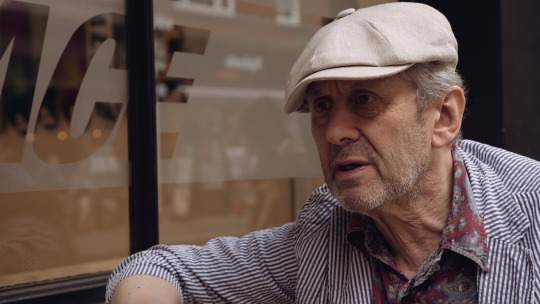






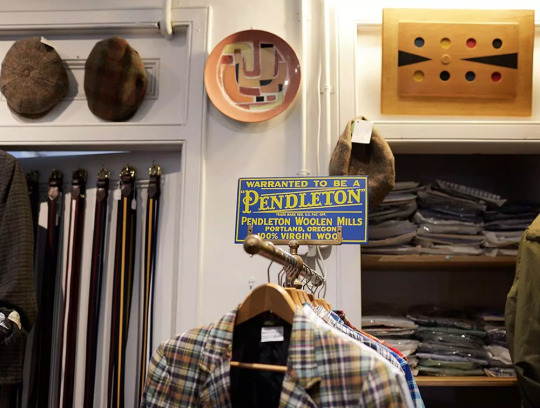
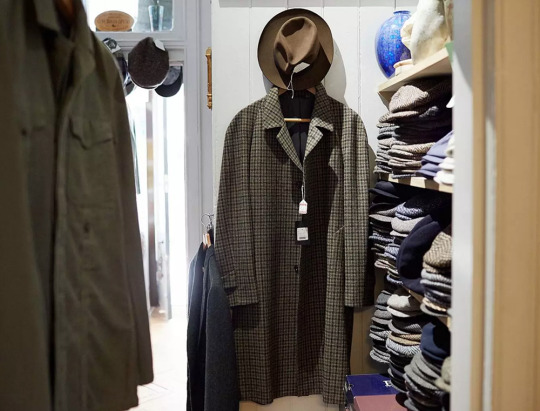





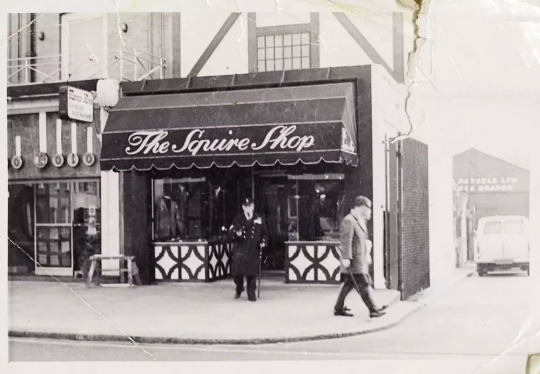


youtube
264 notes
·
View notes
Text
Pandemic Art Photo Challenge
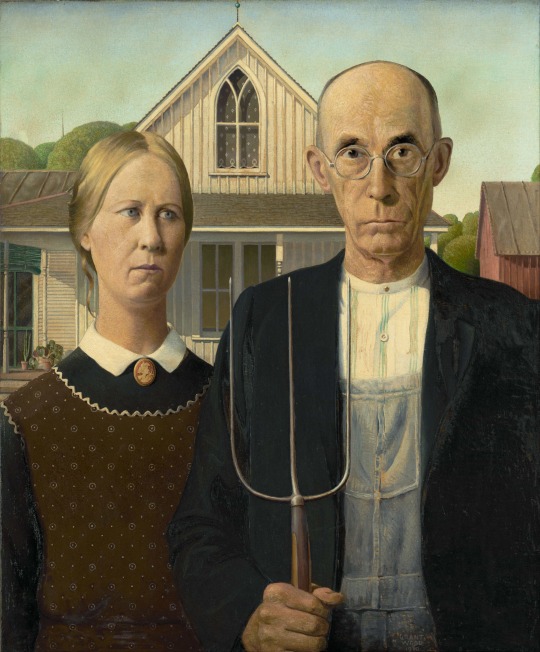

Halsey Redman
Visual Communication
Professor Vukasovich
April 20th, 2021
Your Tumblr assignment this week is to recreate one (choose one) of the following in a photograph and then conduct a holistic analysis of a single image.
Pandemic Art Photo Challenge - Utilizing props and perspectives, recreate an iconic work of art through photography.
Inventory List:
Light Blue Sky with either grey smog or clouds
Rounded, green treetops
A white farmhouse with a front porch, blue door, and church-like windows
A red barn in the back right corner
A man on the right: in light wash, denim overalls, a white button down shirt (with no collar), and blazer. He carries a pitchfork in his right fist. He’s bald and wearing glasses
A woman on the left: in a high colored shirt, under a black sweater, with a gold broach. Over the black sweater is a patterned apron-dress with a tan rickrak edge.
Composition:
The man and women are in the foreground of the painting, making them the subject of the piece. The man’s gaze is straightforward, which makes it seem as though he’s looking directly at the viewer. The woman’s gaze is to the side. The farmhouse, barn, and trees are pushed farther back in the painting, making them the background. The frame of the piece captures the subjects from the waist up.
Visual Cues:
Color: The overall color tone of this piece is quite desaturated, almost like a subtle wash of sepia tone. There’s not a specific direction of light or shadow- making the image very one note or dull, which is most likely intentional given the time period.
Form: The painting was done in a vertical frame. The height of the subjects, combined with the point of the farmhouse helps to support that vertical line.
Depth: The people are very clearly placed in the foreground. The fact that they are larger than the farmhouse and trees helps us to see that.
Movement: The couple looks stuck/trapped in the image because we cannot see their arms or legs. There is, however, a sense of movement for the viewers' eyes because the dark colors in their clothes, combined with the light sky, causes the eye to move upward toward the character’s faces and the point of the house.
Gestalt Laws
Similarity: The similar size of the two people in the foreground causes the viewer to infer that they are connected.
Proximity: The closeness of the two people causes the viewer to think they are connected, perhaps husband and wife,as they are touching each other. The proximity of the couple and the house causes the viewer to infer that the house belongs to them. You can also assume that the man is a farmer because he is holding a pitchfork in his hand in a rural looking setting.
_______________________________________________________________________
American Gothic was painted in the 1930s by Grant Wood. In the 1930s the United States of America (and the rest of the world)was in the midst of the Great Depression. The depression was started after a major decline in the stock market, resulting in a crash that would cause the GDP to fall by 15%. The Great Depression had horrible effects on the rich and poor, as unemployment ran wild. The style of the painting, Regionalism, was a rejection of the modernist influences that were popular in Europe during this time.
The meaning behind American Gothic is a highly debated subject. Due to the time period and the positioning of the two characters, it looks like a farmer and his wife protecting their home and livelihood during a time of great financial stress. Others believe that the man is the woman’s elder, so he must be her father. His gaze directly at the viewer and grip on the pitchfork symbolize him protecting her virtue. Her side gaze is almost sorrowful, meaning she may not be happy about the man’s strict protection.
Overall, the painting causes the viewer to feel uneasy. I have seen this image many times throughout my educational career, so I do have a bit of background knowledge of the historical context. Looking at American Gothic causes me to remember what I learned in school about the Great Depression: how our country went from the lavish culture of the roaring 20s to higher levels of poverty and struggle. The image itself makes me feel very uncomfortable. The man holding the pitch fork is staring directly at me, making me feel as though I’m seeing him in a glass cage at the zoo. The woman’s eyes avoid mine, making me feel as though she’s embarrassed that I’m watching her. My overall emotion is discomfort.
For my “pandemic recreation” I placed myself and my partner as the man and woman in the initial image. However, instead of standing next to each other we are masked and standing six feet apart. Instead of a pitchfork, Nick is holding a cotton swab that is typically used in testing for COVID19. Instead of a farmhouse in the background, I used an image of a Convenient MD/urgent care building. The perspective of the image has shifted in order for the subjects to be farther away from each other. Our facial expressions, however, have the same sort of stoic feeling as the original image. I’ve also placed a “sepia tone” filter over my image to give it the same sort of color scheme as American Gothic
Work Cited
Güner, Fisun. “How American Gothic Became an Icon.” BBC Culture, BBC, www.bbc.com/culture/article/20170208-how-american-gothic-became-an-icon.
Smiley, Gene, et al. “Great Depression.” Econlib, www.econlib.org/library/Enc/GreatDepression.html.
0 notes
Text
It means nothing to me... OH VIENNA! - October 2019 Part 2 of 3
Refreshed after a peaceful night’s sleep (despite the warmth overnight), we left the house to delight in the Viennese sunshine. Today was an art day, but our first stop was the area around Stephansdom, which was a couple of blocks near our accommodation. Stephansdom, or St Stephen’s Cathedral, is an enormous gothic church. The roof is decorated with brightly coloured hexagonal tiles. Tom suggested we take a look inside, but the line to get in was already long, so we deferred it for another day and carried on through the town that was starting to get busy.



We walked around for a couple of hours, starting with all of the shops and then carrying on toward the Belvedere Palace, home of the best collection of Klimt artworks. We stopped at a fountain for a bit to take some photos. The beauty of the city was summed up in this single intersection.
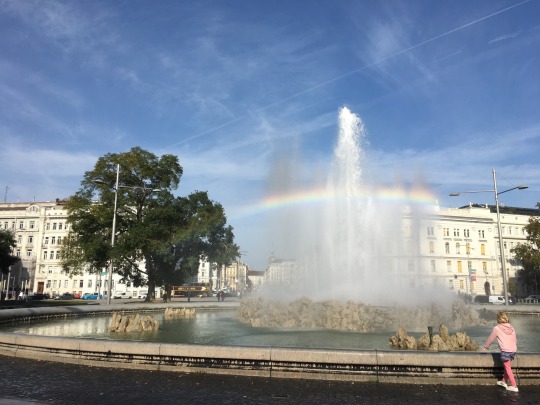

We got to the Belvedere just after lunchtime feeling a little weary. We hadn’t eaten lunch and the heat was a bit relentless. We lined up for tickets and picked a ticket that allowed us into both the Upper and Lower Palaces.
Originally built as a residence for the Austrian Royal Family, the Belvedere Palace was everything you’d expect. Marble and ornate plasterwork, gilding in places you would expect it (and even more where you wouldn’t!) We wandered from room to overfurnished room, taking in the building as much as the artworks themselves.
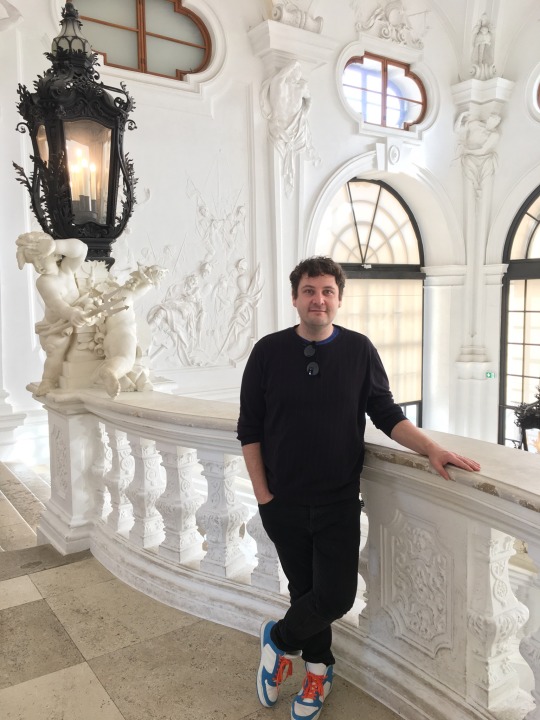

I was hanging out for the clump of Klimt artworks in the Upper Belvedere. Gustav Klimt was one of the founding members of the Vienna Secession, a group of upstarts who wanted to overthrow the old guard of stuffy arts colleges. In the process, they exhibited groundbreaking new works in the 1890s and inadvertently started the modernist art movement, which inspires art and culture to this very day. The jewel of the collection is “The Kiss”, which is a sumptuous representation of a couple in embrace, surrrounded by a flower garden. It is a piece I had always admired and was plastered all over Viennese postcards, tea towels and fidget spinners.
We entered the room where it was. There were a few people hanging around, so I looped the perimeter to view some of his other works while the crowd died down. Just before I’d completed full circle and got into the optimum viewing position, I heard a commotion down the hall. In a flash, a bus load of Japanese tourists entered the room like a family of sardines. I felt cheated but they were stereotypically efficient. Before I could acknowledge the situation, the members of the group had whipped out their selfie sticks and mobile tripods, flashed a few pictures and then carried on. Within two minutes they had all evaporated - as if they had never been there at all. I took my opportunity to slide into the perfect viewpoint and snapped my pictures before I missed out again.
I can’t express how moving “The Kiss” was. It was much larger than I expected, at a whopping 1.8 square metres. The illumination just doesn’t photograph as well as it shows up in person, but here are a couple of the best shots I could get before the jostling crowd behind me started to lean over me to get their snap.

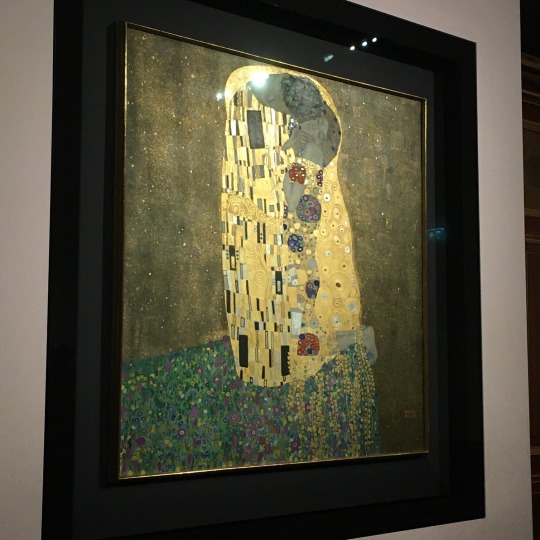
Outside after the Upper Belvedere, we stopped for a break on the steps before the epic garden walk to the lower palace. Tom used the opportunity to pull the Ultravox gag in the video below. My bemused look is due to the fact that this would be about the fiftieth time he had responded to something I had said with, “This means nothing to me.... Ohhhhhhh Vienna”. Not that he would agree, but because it is such a catchy song, it got old pretty quickly.
The lower palace was just as impressive, but I was pretty excited by a special exhibition in the orangery devoted purely to raw materials. It celebrated everything fro gums and varnishes to the pigments themselves. It showed some of the sketchy practices of pigment mines in developing countries (which was an eye-opener) and culminated in a wall of different rocks, beetles and saps used as pigments in art, both traditionally and in modern times.
We left the Belvedere aesthetically satiated and went back to the apartment before heading out for dinner. I had a hankering for the Alt Wien and faced the challenge of the gigantic schnitzel again. After two beers I felt a little beaten when Tom suggested another. I said I could do with a walk first to digest the slice of mammoth I had just undertaken.
When we hit the street the cool evening already started to work its magic. It also carried the low din of a hullabaloo. I suggested we follow it and we ended up back at Stephansdom, where a protest was taking place. Because neither of us know very much German it was hard to determine what the group were protesting about, but it had all of the hallmarks - somebody shouting into a megaphone, flags of varying countries, cultures and sexualities (but no general theme), and an air of stayed danger. We leant back on some railing and watched for a while and the exotic rhythmic chanting was quite relaxing. After a while we carried on and I announced that I was ready for that next drink Tom had mentioned. He suggested we get a cocktail because he’d spotted a shiny cocktail bar further up the street. We got there and it looked a little cheap, so we carried on towards the river. At the end of the path were two pubs on looming competitively on opposites sides of the road. With nothing but intuition, we opted for the one on the right.
Inside the pub it was busy. It had a TGI Fridays vibe, which was fitting because it was a Friday! After work crowds chattered over pints as we slid past and found two stools adorning a beer barrel table on the opposite side of the room. A waitress came over and we ordered a strong beer brewed by the pub. Because they were the only two seats left in the place, we took turns going to the loo, which were down a steep marble spiral staircase. Just outside was one of the valets who provide paper towel for a tip. I regretted the second and third pint, because I was running out of coins to give away, as well as feeling more than tipsy. We opted to finish our beers and get out of the pub - maybe to find another drink somewhere else. I alighted the stairs one last time to discover that the old valet was packed up for the night, but something strange was in her place. What I had assumed was a wall had given way to a tiny basement nightclub. Pink lights flashed and pop dance music blared out. In the loo, Tom appeared and we both commented how surprising it was to discover a secret nightclub. As we walked past it on the way to the stairs, the Vengaboys “Boom Boom Boom Boom!” echoed into the he hall. I grabbed Tom’s hand and danced him in (unsure that we were even allowed in there).
The bijoux nightclub was crammed with people. It had a bar at the back and an enormous communal table took up the majority of the space. Off to the side was a tiny dance floor, not quite big enough for the number of people ready to dance (including the two of us). The rest of the night is a bit of a blur. I remember that they had a minimum card spend limit for drinks, so we were drinking two Corona’s each at any given time. A tall Viennese man grabbed Tom’s curly hair, which had been bouncing in his frenetic dancing. I remember it being hot, so I popped my hat, jacket and bag down beside us so that I could continue dancing.
And the last thing I remember is realising on the walk home that I had left my hat at the bar. Tom said we could go back, but I was far too drunk to face the walk back. Surprisingly, I remembered the door code to the building and our room.
0 notes
Text
When games get Meta, where do they go next?
Now that we’ve discussed the concept of meta and how all-encompassing it can be, we want to be able to break it. But in order to understand how to break away from meta, let’s backtrack a little bit and bring up a little history on and the potential future of video game development.
History of the Artform
youtube
Game Theory: Gaming is BROKEN! ...What Comes Next?
While doing some digging for videos to support research into the Philosophy Point, I immediately remembered this video by YouTube creator MatPat of the Game Theorists, uploaded in late November of 2017. During its runtime, MatPat postulates for his viewers a theory about where video games and its industry as a whole is heading. While more diluted with its presentation, with an audience aimed less at academia and more at (the gamer subset of) the general populace, the video still does a fantastic job of encapsulating its message in less than fifteen minutes.(1)
As an abstract of the video, Matpat first does a rundown of where video games stand as a medium in today’s industry. In a word: struggling, causing gamers to become more disillusioned with the Triple-A, what one would expect to be the best of the best. Here we segway to a short description of earlier video games, as well as a small focus on the current “Revolution” of Indie Games and Indie Development, a subtype of video game characterized by “often [being] created without the financial support of a publisher, although some games funded by a publisher are still considered “indie”.”(2) Matpat details notable examples, both old and recent, strange and stranger. When games become meta, Matpat drops the Game Theory on the viewer: he relates these trends in gaming to the movements in modern art history, stating that those trends can be used to predict the future of the video game as a medium. With brief explanations of these periods of art, citing notable figures and ideas in the movement being discussed, they get related back to the relevant period of gaming. From its real earnest start in the 80′s to the point video game growth followed the exponential growth of technology, to the way games are today, the theory makes an educated guess that video games of the foreseeable future will eventually follow these historical art trends that set their precedents decades ago.
That’s so meta!
Do you get what that means? To paraphrase Game Theory video example again, video games have evolved in stages of growth much if not exactly like eras (or macro-trends) of modern art, only at a much faster rate. History is repeating itself.
Before, the only limitations to video games evolving as a medium were the lack of technological sophistication, learning and understanding of the medium, as well as the lack of a more connected platform, the Internet and Internet-based distribution. But as technology advanced faster and faster, so too did the depth and complexity of video games. Much like how Modernism began and proliferated.
Modernism was a philosophical movement that shaped and transformed Western society during the late 19th and early 20th centuries, described in the video with the catchphrase “Make it new!”

Likening this past and fast growth of the Video Game to the Modernism movement makes perfect sense in context. Modernist artists and writers wanted to break away from the meta, creating new, yet unthought and unseen ways of creating art. The same can be said of developers after the mid to late 2000′s, using every inch of new technology, ever new technique to make games that were better, deeper, more complex, lifelike, and emotional. Every innovation made used to chase the golden concept of Immersion. To feel enveloped in the narrative of the game or present inside the scene depicted by a modern art masterpiece, and nothing else, a temporary escapism of our world into the ones created for us.
Parallax
Where does that leave us right now? Back in the struggle of the face of the video game world, the Triple-A games that should represent the apex of the modernist video game movement, where the meta now is the expectation of the best. All those years of advancements culminating in the art of distilling the best stories, best graphics, best mechanics, best of action, emotion, drama, everything that makes a game lifelike and immersive.
Except it’s not always like that, is it?
Well made sequels to triple-A games are getting lesser sales than their originals, even though they’re often only a couple years apart. Other titles are missing the mark for user interaction, making things feel less immersive than their marketing and budget would often suggest. What’s happening?
In the video, Matpat mentions the Indie Gaming Revolution that’s happening right now. Ever since the likes of Braid and Super Meat Boy, Indie Games have evolved alongside the mainstream, much like how Postmodernism was born before the end of Modernism. A subtle paradigm shift is happening.

(4)
The Postmodernism of video games is already here and steadily outgrowing the meta of idealistic photo-realism of modernist triple-A games, with the exception of a few new well-received titles here and there. Most of the attention of gamers and the media that they consume is being drawn more and more to these Indie Games, especially the ones that proudly display well-honed values of gaming’s version of Postmodernism. That is to say, the rise of a counter-culture, born as the medium’s reaction against modernism, a response to, rejection of, and commentary on itself. Games like Doki Doki Literature Club!, a spin on the classic Japanese dating sim genre, turned on its head into a terrifying psychological horror game. Or the birth of sub-genres in the Indie world, like rage games, games specifically designed to be difficult not in an effort to produce a challenge, but to incite the opposite of the satisfaction in surmounting it. As well as the fact that the abstraction in these games are becoming so much that they begin to stretch what it takes for a game to be considered a game, much like Postmodern art. Meta, I know.
Just like postmodernism in art, this new wave of Indie games rising in popularity is due to the growing staleness of the modernist form. The disillusionment brought on by frustrating monetization techniques within triple-A games. The diminishing return of photo-realistic graphics, when most modern games, despite the platform they are played on, are arguably already so good looking that the differences are negligible, leading to the feeling that it is no longer as revolutionary as it once was. Add to these reasons the fact that an Indie Game isn’t usually tied down by corporate restraints. No sense of feeling like a cash-grab, no microtransactions to plague it. A simple and pure expression of the creator(s) visions. It’s not a wonder that indie games, and games that take into account these purer, postmodernist values shine brighter more often in today’s public eye.
Heads in the clouds
MatPat’s video continues after Postmodernism to postulate the future of video games, the Post-postmodernism stage. Where gamers will eventually get tired of the meta-commentary, where tear-downs of the artform become the new norm, and therefore the users begin to wish to return to what came before. However, to avoid simply paraphrasing the entire video and restating facts and opinions I’ve already said several times in the same post, we ask the question: Where does all this theorizing lead for myself and my team?
To consider games as an art form is to also say that they hold an influence over culture, in the way it affects or reflects on society, politics, economics. In order to return to the ground after floating about, we need to turn our attention away from the higher theory. Stop looking up at the future and its potential for a moment, and look around at the now in order to find our teams place in the landscape of our chosen genre. See my next post for more.
Sources:
https://www.youtube.com/watch?v=gxzKZdTxNp8
https://en.wikipedia.org/wiki/Indie_game
http://www.tate.org.uk/art/art-terms/m/modernism
http://www.tate.org.uk/art/art-terms/p/postmodernism
1 note
·
View note
Text
Libra September Feast of Divine Life

By shirleytwofeathers
The Autumnal Equinox festival is known in some traditions as Cuivanya or the Feast of Divine Life. This particular version of this celebration of the Autumnal Equinox is a holy day in the Filanic tradition.
What is Filanism?
Filianism (the “Daughter Tradition” – from filia,daughter) is a religion that is sometimes considered to have started, or taken its current specific form, in the 1970s, since that is when it first became publicly known. Its first recorded modern appearances were in Britain, although some have postulated a Greek or Asian origin for its Scriptures and philosophy.
It is one of the four Cardinal Feasts of the year, and stands at the centre of both the Mysteries of Life Cycle and the Mother Half of the year. It falls on the 17th of Abolan the apple-month (21st September) – approximately at the autumnal equinox.
The element governing the Fall season is Earth, and the festival itself is often considered to be the Harvest Festival.
While the association of the Mother God with the element of earth (the Earth Mother) has its roots in patriarchal “demotion” of the divine feminine to the lesser elements – attempting to make Her earthly and lunar as opposed to Solar and Spiritual – it must be remembered that in the beginning, the Mother Goddess was rightly understood to rule all elements of creation. Thus the patriarchal error lies not in seeing the Goddess as Earth Mother, but in seeing her only as Earth Mother and not also as Sky Mother, Solar Mother, and Queen of Heaven.
The idea of a Harvest Festival is often seen as “primitive” people, dependent on agriculture, giving thanks for their material survival and for the harvest that will permit them to eat. They then (according to “scientific” thinking) invent “gods” as a sort of imaginary explanation of the physical realities of life.
In fact the reverse is true. Our ancestors lived far closer to the Spirit than we do. Everything they did was spiritual first and physical second. The transition to agriculture was fundamentally a spiritual phenomenon. It was a part of the increasing materialisation of maid: her becoming more and more a creature living on the physical plane.
But this in itself was spiritual: part of the process of cosmic manifestation. The rituals of agriculture were rituals first and practicalities second. They represented a new spiritual orientation for earthly life which remains with us to this day.
The central symbol of the autumnal equinox Harvest Festival, is the scythe or sickle. This is a symbol that represents both life and death. It symbolises the harvest and the abundance of the earth, the coming to fruition of all the good things that have been planted and tended, both materially and spiritually. At the same time it represents cutting-down and death. The death of the individual, and ultimately the death of the cosmos itself, when all creation is in-breathed back into Absolute Deity, the Dark Mother who out-breathed the cosmos in the beginning.
Indeed, the Feast of Divine Life, while it is devoted to the entire Trinity of Mother, Daughter, and Dark Mother may also be called the true Feast of the Dark Mother (and indeed the festival marks the beginning of the dark half of the year).
The Dark Mother, or Absolute Deity (nirguna brahman – God Beyond Form) is called “Dark” because we can know nothing of Her. As the Vedantins put it, we can only assert of Absolute Deity: neti, neti “not this, nor this”. Yet while She appears Dark to us, the Dark Mother is hailed as “Dark beyond the Light and Light beyond the Darkness”. At Her darkest (from the worldly point of view) she is the “grim” Reaper, reaping not only the human soul at the end of a single life, but the entire creation at the end of all worlds.
But reaping has a double significance. In one sense it is “death” but in another sense it is harvesting, the coming to fullness and consummation of life. And it is this fullness and richness of Divine Life that is the primary theme of the great festival of the autumnal equinox.
The Dark Mother is likened to “Earth” in its most metaphysical sense, as the Ground of All Being. As it says in the Scriptures: “Let her not trust the ground her feet are set on, and doubt the Ground upon which that ground stands.”
From the human, or worldly, perspective, the Dark Mother is the third person of the Trinity but from the spiritual perspective, She is the first, the very foundation of the Trinity itself. That is why the Festival of the Trinity is also the Festival of the Dark Mother, because, in focusing on the whole Trinity, and not just Mother/Daughter with the Dark Mother in the background, we have to see the Dark Mother as the “First Principle and the Final Cause” not only of the cosmos, but of the Trinity Itself.
The Dark Mother is the Ground from which all being proceeds, and the sickle that harvests it when its cycle is complete. She is “the Beginning and the End”. While the first feast of the Mysteries of life cycle, the golden Festival of Regeneration (Chelanya), celebrates renewed life, and the last, the Feast of the Dead (Tamala), celebrates death, the central autumnal equinox festival of Cuivanya celebrates life and death at once in the sacred mystery of the Harvest – the “death” that comes as the culmination and fulfilment of Life. The death to this world that is birth to a higher world.
And yet, of course, it is not death but life that is the primary focus of this autumnal equinox festival, and not simply life in the ordinary sense, but the fundamental connection of all life with the Divine, and as such, it is necessarily also the feast of the Holy Trinity, since the Divine Life that creates the universe is inherently threefold.
The Trinity of Our Mother God (sometimes called the “Triple Goddess”) is often compared to the Hindu Trimurti – Creatrix (Mother), Preserver (Daughter), and Destroyer (Dark Mother) of the worlds (or with their lesser reflection, the Three Fates, spinner, weaver, and cutter of the world-thread). But while it is true that the Dark Mother, or Absolute Deity, in-breathes all life and all being at the end of time, it is equally true that She out-breathes it at the dawn of time. She is both the first Sower and the final Reaper of all life and all creation. From Her proceeds the bright Solar Mother who creates the worlds, and from the Solar Mother proceeds the Lunar Daughter who maintains them in being for the whole of their existence.
Nothing exists outside the Divine, and all things are part of the Divine Life. While modern people tend to see much of the universe as “inanimate” or “lifeless”, our tradition teaches us that all things are infused with the Divine Life. The universe is ensouled – not in the same way that we are, but everything that is is infused with the Divine Intelligence. That is why, for example, the movements of the stars and planets are connected with the events of human life – not because one directly affects the other, but because both are part of what has traditionally been called the anima mundi, or world-soul, (but which, for the sake of disambiguation, we might prefer to term the cosmic soul).
Divine Life is present throughout the cosmos, not just in human, animal, or vegetative life, but in all creation, and this autumnal equinox festival traditionally expresses that through the agricultural symbolism of the harvest, which is not simply a “metaphor” but a ritual in the fullest and deepest sense of the world, reaching back into the times when all human activities were spiritual rites first and worldly activities only secondarily.
The very biological, chemical, cultural, and psychological factors that make agriculture both possible and necessary are bound up intimately with the living symbolism of the cosmos and our earthly microcosm thereof.
The truth is the exact reverse of the “modernist” or “evolutionist” notion that physical facts come first and metaphysical Truth is secondary. In reality, all things are spiritual first and physical only secondarily and reflectively.
Which is simply another way of saying that Our Mother God is the Ground of All Being, and that every aspect of the cosmic whole is simply an expression of the Divine Life that underlies it.
That is the fundamental Truth of the Feast of Divine Life, the great festival of the autumnal equinox. It is a celebration of the Divine that is present in all things and manifested to us in the wonderful golden abundance of the harvest, the yearly culmination of our dear Mother’s nurturing love for Her children.

Ideas for Celebrating the Feast of Divine Life
Prepare a feast!
Traditional foods include apples, cider, and seed cake. Fruits and vegetables that have ripened at this time of year are also appropriate. Don’t forget to thank the Goddess for the food on your table and all the many blessings She has given you!
Decorate your shrine
Decorate your shrine with the fruits of the season, especially apples, as they represent the golden apples of Avala! A brief summary of he symbolic significance of the apple and Avala is given below:
Avala is the Earthly Paradise, for although beyond this physical world, it is still below the level of pure Spirit as the resting place for spiritually awakened but still imperfect souls. The Tree of Life, at its centre, bears the golden apples of life eternal. The word “paradise” comes from a root-word meaning “orchard”. Avala and Elysium both mean “apple-land”. In many traditions, from the Sumerian and Greek to the Aztec, this paradise has been pictured as a mountain-top orchard which, in all earlier and most later accounts, belongs to a “goddess”. Thus the Sacred Mountain is Her mountain; the golden apples Her apples, for Hers is the gift of eternal life.
Perform a Rite of Sacrifice
This can be an elaborate ritual, or a simple offering of food and wine. The basic prerequisite is that what is sacrificed to the Goddess must be something of value. It can also include a sacrifice of time and energy. For example: you could offer up Saturday mornings to volunteer to help feed the homeless, or time and energy to work in a community garden.
Pray the Filianic Rosary
The purpose of these is to allow a Catholic-style rosary to be prayed by individuals and groups who worship the Mother God in Her Trinitarian form, as God the Mother, God the Daughter, and the “Dark” Mother who is Absolute Deity, beyond being and unbeing; as set out in The Filianic Creed.
Here’s a nice example of a Hail Mary:
Hail Mary, fount of Grace
Lady of earth and Heaven
Blessed art Thou by all maidens
And blessed is Thy most beloved daughter,
Holy Mary, Mother and God,
Shelter us fallen ones now and at the hour of hour death.
Read passages from the Filianic Scriptures.
The scripture passage for the Feast of Divine Life is found in The Crystal Tablet, Verses 12-29, as given below from the Lux Madrian version:
12. Life is the life of the spirit-the first principle; beyond being and unbeing. Life was before existence. Life is the cause of existence.
13. How shall the soul live in Life?
14. Let her realise the truth of herself and the Truth of the Absolute. Let her know that her life is beyond even her existence, that the Absolute Life, the Life of the Goddess, is beyond all existence.
15. Let her not be held from herself or her Goddess by anything that exists, for all the things that are have come from nothing and to nothing shall return. But the Divine Life, and her life within it, Was ever and ever shall Be, though time itself shall only last a space.
16. Let her not trust the ground her feet are set upon and doubt the Ground upon which that ground stands. Rather, let her doubt the sea, the sky, the fingers of her hand, and the breath of her mouth; for all these things may be illusions, as in some sense they are.
17. But let her know Life Divine as the Truth beyond truth and the Faith beyond faith and doubt.
18. Life is pure force, or energy, or delight. It is the joy of the Goddess, and Her breath and Spirit.
19. Light is the outpouring of Life into existence. All things that exist come from Life; they are made and sustained by Light.
20. Though an existing thing appear never so solid, yet its body is made of light. All material things are but consolidated force; and the vibration of force is the whole of their being.
21. Yet material things are far from the Source of Light. They have become subject to consolidation and restriction.
22. Pure light knows no bounds, but is perfect joy, and breathes its own perfection.
23. How shall the soul approach to Light?
24. Let her make her every act a resplendent creation, and let every outpouring of her energy be a well-made gift for her Lady. Let her not fall into dullness, but be ever creating herself anew in the delight of her energy.
25. Let her not seek for reward, but only for her own perfection; thus shall the action itself become perfect. Let her turn from the transient and find delight in the Eternal.
26. For every earthly action is the shadow of some higher form; and the soul must choose whether in her act she shall approach that form, or sink from it into deeper shadows and the morass of illusion.
27. She who rejects the light of the Spirit in this world shall, beyond death, be plunged into darkness and the confusion of bodiless echoes.
28. But every act that is performed in dedication to the Mother is an expression of the soul’s true self, and loosens the chains of her bondage.
29. If the soul live in Light, no thing shall be impossible to her, for her will shall become one with the will of our Lady.
Sources:
Mother God
Goddess of 10,000 Names
https://shirleytwofeathers.com/The_Blog/pagancalendar/category/september-days/
0 notes
Text
You’re there physically through your object
(You can find this text in Swedish here).
Visual arts is a field that sometimes overlaps the venues and practices of performing arts. Despite this, I don’t know that many purely visual artists. When I wanted to talk to someone who was clearly rooted in visual arts, a friend referred me to Katja Larsson, among other things because they recently ran into each other during parallel work travels.
Katja is based in London, but I had the opportunity to meet her over coffee at Stockholm central station. She came directly from the airport bus to the cafe. In the conversation, the objects around us came to play an important part. The means of transportation, the bench, the glasses, the paper tablecloth – what do all these objects say about us when they are put in motion through us?
Katja Larsson:
My ordinary travelling route was always to Stockholm, because my family lives here, and now most of my jobs and the gallery representing me are here as well. I have lived away for twelve years, all in all. First, I was in a folk high school for two years in Scania, then I moved to Glasgow to study and then I settled in London. The trip to Scania was the most difficult one. It was more expensive, longer and more complicated than going to Glasgow or London. In addition to that, there was no Internet in the cottage where I lived. The landline was my only means of staying in touch with people. Because of how the technology has developed, it’s cheaper and easier now when I live in London. I can write and call for free with wifi through a lot of different services. It also makes it feel very close, almost like I wasn’t somewhere else.
But I don’t want to move back home. And with back home I now mean where I was born. I say home about both places depending on where I’m going. I like living in London. I had a long-term relationship there until recently, and I thought that was why, but when we broke up I realised it was about the city as such, not just friends and contexts. I think I’ve toughened up living in a big, annoying city, that it has changed my ideas and made me develop faster. If I want to check out a style or an epoque, there’s always an exhibition about it. And there’s so much junk everywhere, so much life and movement, it’s inspiring for me. A more empty and tidy place isn’t.
I also think there might be an interest in what I’m doing precisely because I’m not doing it in Stockholm. I often get visits in London from my gallerists and others. The exchange and travelling are a very important part of the art world. People come to London sooner or later because it’s a cultural centre. That’s yet another reason to live there.
To have a gallery representing you doesn’t mean you get a stable monthly salary. You can get commissions from them and they can sell your art, but there are no guarantees. Everything is about how much you sell and how interesting you are. So, you just have to stay interesting.
There is no job security for me whatsoever. You can’t work as an artist if you have a nervous disposition. You need a buffer, preferably a couple of annual salaries, because that’s how long it might take to get a commission and then get paid for it. So, you have to save the money from your last job to be able to take the next one. You need to just forget that the money is in your account. Or, you have to remember that it’s your monthly salary for one and a half years ahead. Then it’s not that much, all of a sudden.
Because you never really know what will happen, I’ve always had a part-time job. It’s also nice to have a dynamic life where you meet other people a few days a week. Another reason why I’ve kept my job despite not really needing it anymore financially is Brexit. If Brexit goes through, it would be hard for me as self-employed with incomes from other countries to prove how long I’ve lived in Britain, but being employed makes it quite simple.
Older artists have told me that I should devote myself fully to the art world, that that’s how it’s should be done. But I think this romantic notion is a bit overrated. Also, to do that you need to travel around from art fair to art fair and tag along everywhere. And to be honest, I’m not that enthusiastic about living in hotels and being on tour. It was not as glamorous as I thought.
So, I avoid travelling through my part-time job. All the same, if I wasn’t obliged to be in London two days a week, maybe I could have scheduled my travel so I could do everything I need to do in Stockholm in three weeks, so I wouldn’t have to travel so much the rest of the year.
I sometimes think of the implications of moving to a country where I have to fly to get to Stockholm and back easily. It’s possible that I would have thought differently if I had made that choice today. I recently did a test to see how much CO2 I consume. Despite being a vegetarian and a cyclist, I still didn’t score under the two-tonne limit. And now I’m depending quite heavily on the existence of the air route. Travelling in any other way takes like three days and is really expensive. For me to make a different choice, the train traffic would need to expand and become radically cheaper.
I travel mostly between London and Stockholm, but a few times a year I go to places that are not home in any way. If your works are easy to install, someone else can do it for you, but some of my objects are rather large and have to be taken apart and then reassembled. I often get to do this myself. Other objects that are a bit easier to deal with, that can be hung on a wall or stand on a pedestal, can travel on their own. For me, it’s a bonus when the objects are put into motion in a way that is not actually a part of their history as sculptures. Like a series of excavator buckets I cast in stone. Excavator buckets aren’t valued very highly in everyday life, so it’s fun that they get to go on tour. Or like when five muscular guys plodded through the streets with a large, fragile tractor wheel made of paper, because it was tricky to get it into the gallery.
I think a lot about movement when it comes to objects. For example, I’m fascinated by motorbikes, even though I’m not a motorcyclist myself, but because they are aerodynamic and tilt when going round bends and so on. If I work with motorbike parts as a visual artist, that motion is embodied in the static object. For this reason, a word I tend to use when I describe objects in English is “vehicle”. It is a means of transport, but it can also be “a vehicle for change”, for example. My objects are not vehicles, strictly speaking, but as an artist you don’t have to use the right words. For instance, I often say that the objects have evolved. “This motorbike has evolved into a classic stone artefact.” It sure hasn’t, I made it. I can really forget that. I experience the objects as wanting things, knowing things in themselves.
If I were to say something about the airplane as an artistic object, what first comes to mind is the feeling of not understanding why it’s moving so fast. It’s like looking at a map, everything becomes so small and then I’m there. I think of the early trains that travelled at thirty kilometres an hour. People threw up because they couldn’t handle the speed. Have we really found a way of dealing with the velocity of an airplane, or is it just that we don’t grasp it?
The airplane is also a weird, a heavy object hovering in the air. But if I were to choose only one object that could do that, I would choose the zeppelin instead. An airplane has too many parts jutting out. And it’s too logical, it looks like a bird. A zeppelin could just as well be a submarine, and then the sky could be water. Objects are interesting if they have an ambiguity, if you can read it as more than one thing. Zeppelins are whales, Moby Dick, Leviathan. The zeppelins have a fundamental sculptural language, as in modernist or African sculpture. Also, there is this aspect that the zeppelin never became anything. The idea was a failure, just like the Vasa ship.
But airplanes, zeppelins and the Vasa are actually a bit too large for me. I stick to the human scale when I build. My casts are often just on the verge of what I myself can carry, so it’s a struggle to get them home. Maybe it’s related to me playing the double bass in a symphonic orchestra at high school. Always when I see someone carrying a double bass, I feel such an incredible respect for that person. In some ways, the orchestra life is quite similar to being an artist, because there you also travel with an object. And the double bass or the sculpture protects the whole of you. You don’t really need to be visible. You are there physically through your object.
But I’ve more or less stopped transporting things myself. Just because you can drag something in your backpack on a plane it doesn’t mean you should. Even if art is my passion, it’s also my job. With a job you have boxes, transportation and insurance. The things have a value beyond how I myself see it, and it has to be protected. I have learnt through experience that travel and shipping expenses need to be covered. So, movement is included in the budget for the art piece.
One thing that I have done on the travel budget for the art piece is to go on adventures to extreme locations to make casts of large rock surfaces and other natural objects. The adventurer is a character I use. Imagine Kaspar David Friedrich in a suit, gazing out at a stormy ocean thinking he’s in control; the human who thinks he can control nature.
I ended up there through a project about the anthropocene, geology and the end of the world. It started with me casting a mould of a huge stone and reconstructing it in pink silicone. After that I started researching geology and rheology, which is about, for example, stones having a fluid quality over time. That took me to the anthropocene and how humans have changed the crust of the earth since the industrial revolution. I realised the silicone stone is not just a sculpture, but a representation of something that is actually happening. Stones these days can consist of plastic to quite a high degree.
There’s this book called Machine by Peter Adolphsen. A short passage describes a prehistoric eohippus – a tiny, tiny horse – running through the woods, stumbling on a root, falling down a hole, dying, being covered by a layer of vegetation, being squeezed together during hundreds of thousands of years, transforming into oil. Then someone comes and extracts the oil. Someone pumps it into a car. Someone drives the car. It becomes exhaust that a lung breathes in.
That time travel infuses a kind of poetry into things that we don’t often consider to be poetic, such as petrol or exhaust fumes. Even if I don’t like exhaust fumes, this transformation of oil is among the most fascinating things there are, artistically. How can we build stuff that is so much stronger than ourselves? How can we destroy ourselves in this way? How can a million-year journey – the time it takes from the horse falling until it becomes oil – be combusted in a Ford in half a second?
It’s a slow journey here and now, because nothing in particular is happening in this room. But look around you. This is paper. This is plastic. It’s everywhere. Maybe this was once a dinosaur?
I can imagine the world becoming a floating mess of things, a sideways evolution where things start to cross-fertilise. Suddenly, this bench is made of glass, or water. Things decay and shift shape without us.
0 notes